#Hygienic Point Level Sensor Market
Text
Hygienic Point Level Sensor Market Upcoming Trends 2032

The competitive analysis of the Hygienic Point Level Sensor Market offers a comprehensive examination of key market players. It encompasses detailed company profiles, insights into revenue distribution, innovations within their product portfolios, regional market presence, strategic development plans, pricing strategies, identified target markets, and immediate future initiatives of industry leaders. This section serves as a valuable resource for readers to understand the driving forces behind competition and what strategies can set them apart in capturing new target markets.
Market projections and forecasts are underpinned by extensive primary research, further validated through precise secondary research specific to the Hygienic Point Level Sensor Market. Our research analysts have dedicated substantial time and effort to curate essential industry insights from key industry participants, including Original Equipment Manufacturers (OEMs), top-tier suppliers, distributors, and relevant government entities.
Receive the FREE Sample Report of Hygienic Point Level Sensor Market Research Insights @ https://stringentdatalytics.com/sample-request/hygienic-point-level-sensor-market/1968/
The hygienic point level sensor market caters to industries where strict hygiene and sanitation standards are essential, such as food and beverage, pharmaceuticals, and biotechnology. These sensors are used to monitor and control the level of liquids, powders, or granular materials in tanks and vessels while maintaining cleanliness and compliance with industry regulations.
Report Consumption Analysis:
Consumption analysis in a market report for hygienic point level sensors typically includes data on the demand for these sensors across various industries. It may provide insights into factors driving consumption, such as increasing automation in food processing, the need for accurate level measurements, and regulatory requirements for hygiene and safety.
Key Vendors:
Key vendors in the hygienic point level sensor market are companies that manufacture and supply these sensors. Potential key vendors may include:
Endress+Hauser Group
VEGA Grieshaber KG
ABB Ltd.
Emerson Electric Co.
Siemens AG
Anderson-Negele
IFM Electronic GmbH
KROHNE Messtechnik GmbH The report may provide information on their market share, product portfolios, global presence, and strategic initiatives.
Market Segments:
Segmentation in the hygienic point level sensor market can be based on various criteria, including:
Industry Vertical: Different industries have unique requirements for hygienic point level sensors, such as dairy processing, pharmaceutical manufacturing, and brewing.
Type: Segmentation by sensor type, such as capacitive sensors, conductive sensors, or optical sensors.
Application: Different applications, including liquid level monitoring, interface detection, and powder level sensing, may require specialized sensors.
Business Overview:
This section of the report provides an overview of the current state of the hygienic point level sensor market. It may include information on market size, growth trends, competitive landscape, and key players. A SWOT analysis could highlight the strengths, weaknesses, opportunities, and threats in the market. Financial performance, recent developments, and growth strategies of key vendors might also be included.
Upcoming Trends:
The report may forecast or suggest potential upcoming trends in the hygienic point level sensor market. Some trends to watch for may include:
Industry 4.0 Integration: Integration of sensors into Industry 4.0 and smart manufacturing systems for real-time monitoring and data-driven decision-making.
IoT Connectivity: Use of IoT-enabled sensors for remote monitoring, predictive maintenance, and improved efficiency.
Hygienic Materials: Development of sensors made from materials that comply with strict hygiene standards and are resistant to corrosion and contamination.
Increased Automation: Growing adoption of automation in food and pharmaceutical production, driving the demand for precise and reliable level sensors.
Regulatory Compliance: Ongoing focus on compliance with hygiene and safety regulations, leading to the adoption of sensors that meet industry standards.
Customization: Demand for sensors tailored to specific industry requirements, leading to customized sensor solutions.
Key Benefits of Hygienic Point Level Sensors:
Improved Hygiene: Hygienic point level sensors are designed to meet stringent cleanliness standards, ensuring that they can be used in sanitary and sterile environments without introducing contaminants.
Enhanced Product Quality: These sensors help maintain consistent product quality by ensuring that tanks and vessels are filled to the correct level, preventing underfilling or overfilling.
Regulatory Compliance: They assist industries in complying with strict regulatory requirements related to hygiene and safety, reducing the risk of non-compliance fines.
Reduced Product Loss: Accurate level monitoring minimizes product wastage by preventing spills and overflows, leading to cost savings.
Process Efficiency: Automation and real-time monitoring enabled by these sensors improve process efficiency, reducing downtime and optimizing resource utilization.
Remote Monitoring: Many hygienic point level sensors offer remote monitoring capabilities, allowing operators to track levels and receive alerts from a distance, improving operational flexibility and responsiveness.
Market Segmentations:
Global Hygienic Point Level Sensor Market: By Company
• GHM Group
• Siemens
• Anderson-Negele
• SICK Vertriebs
• Petrotek
• Ferret
• Tempcon
• Hidroteka
• Baumer Group
• OMEGA Engineering
Global Hygienic Point Level Sensor Market: By Type
• Contact Type
• Non-contact Type
Global Hygienic Point Level Sensor Market: By Application
• Petrochemical
• Metallurgy
• Electricity
• Pharmaceuticals
• Others
Regional Analysis of Global Hygienic Point Level Sensor Market
All the regional segmentation has been studied based on recent and future trends, and the market is forecasted throughout the prediction period. The countries covered in the regional analysis of the Global Hygienic Point Level Sensor market report are U.S., Canada, and Mexico in North America, Germany, France, U.K., Russia, Italy, Spain, Turkey, Netherlands, Switzerland, Belgium, and Rest of Europe in Europe, Singapore, Malaysia, Australia, Thailand, Indonesia, Philippines, China, Japan, India, South Korea, Rest of Asia-Pacific (APAC) in the Asia-Pacific (APAC), Saudi Arabia, U.A.E, South Africa, Egypt, Israel, Rest of Middle East and Africa (MEA) as a part of Middle East and Africa (MEA), and Argentina, Brazil, and Rest of South America as part of South America.
Click to Purchase Hygienic Point Level Sensor Market Research Report @ https://stringentdatalytics.com/purchase/hygienic-point-level-sensor-market/1968/
Report includes Competitor's Landscape:
➊ Major trends and growth projections by region and country
➋ Key winning strategies followed by the competitors
➌ Who are the key competitors in this industry?
➍ What shall be the potential of this industry over the forecast tenure?
➎ What are the factors propelling the demand for the Hygienic Point Level Sensor?
➏ What are the opportunities that shall aid in significant proliferation of the market growth?
➐ What are the regional and country wise regulations that shall either hamper or boost the demand for Hygienic Point Level Sensor?
➑ How has the covid-19 impacted the growth of the market?
➒ Has the supply chain disruption caused changes in the entire value chain?
Customization of the Report:
This report can be customized to meet the client’s requirements. Please connect with our sales team ([email protected]), who will ensure that you get a report that suits your needs. You can also get in touch with our executives on +1 346 666 6655 to share your research requirements.
Enquiry Before Buying @ https://stringentdatalytics.com/inquiry/hygienic-point-level-sensor-market/1968/
About Stringent Datalytics
Stringent Datalytics offers both custom and syndicated market research reports. Custom market research reports are tailored to a specific client's needs and requirements. These reports provide unique insights into a particular industry or market segment and can help businesses make informed decisions about their strategies and operations.
Syndicated market research reports, on the other hand, are pre-existing reports that are available for purchase by multiple clients. These reports are often produced on a regular basis, such as annually or quarterly, and cover a broad range of industries and market segments. Syndicated reports provide clients with insights into industry trends, market sizes, and competitive landscapes. By offering both custom and syndicated reports, Stringent Datalytics can provide clients with a range of market research solutions that can be customized to their specific needs.
Reach US
Stringent Datalytics
+1 346 666 6655
Social Channels:
Linkedin | Facebook | Twitter | YouTube
0 notes
Text
Global Top 4 Companies Accounted for 38% of total Hydroalcoholic Gel market (QYResearch, 2021)
The hydroalcoholic gel or hydroalcoholic solution exists and has been used for several years in the health sector. Its usefulness is to be able to maintain a level of hygiene in the cases where the hand washing is not possible either for reasons of frequencies (number of washing in the day) or for reasons of practicality (absence of point of water). A hydroalcoholic gel is mainly composed of alcohol which gives it its disinfecting properties.

According to the new market research report “Global Hydroalcoholic Gel Market Report 2023-2029”, published by QYResearch, the global Hydroalcoholic Gel market size is projected to reach USD 0.21 billion by 2029, at a CAGR of 7.1% during the forecast period.
Figure. Global Hydroalcoholic Gel Market Size (US$ Million), 2018-2029
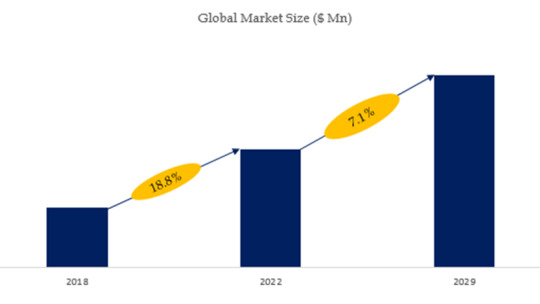
Based on or includes research from QYResearch: Global Hydroalcoholic Gel Market Report 2023-2029.
Figure. Global Hydroalcoholic Gel Top 7 Players Ranking and Market Share(Based on data of 2021, Continually updated)

Based on or includes research from QYResearch: 2021 data information of Global Hydroalcoholic Gel Market Report 2023-2029.
The global key manufacturers of Hydroalcoholic Gel include Cooper, Puressentiel, Vesismin Health, Laboratoires Majorelle, Huckert's International, etc. In 2020, the global top four players had a share approximately 38.0% in terms of revenue.
About QYResearch
QYResearch founded in California, USA in 2007.It is a leading global market research and consulting company. With over 16 years’ experience and professional research team in various cities over the world QY Research focuses on management consulting, database and seminar services, IPO consulting, industry chain research and customized research to help our clients in providing non-linear revenue model and make them successful. We are globally recognized for our expansive portfolio of services, good corporate citizenship, and our strong commitment to sustainability. Up to now, we have cooperated with more than 60,000 clients across five continents. Let’s work closely with you and build a bold and better future.
QYResearch is a world-renowned large-scale consulting company. The industry covers various high-tech industry chain market segments, spanning the semiconductor industry chain (semiconductor equipment and parts, semiconductor materials, ICs, Foundry, packaging and testing, discrete devices, sensors, optoelectronic devices), photovoltaic industry chain (equipment, cells, modules, auxiliary material brackets, inverters, power station terminals), new energy automobile industry chain (batteries and materials, auto parts, batteries, motors, electronic control, automotive semiconductors, etc.), communication industry chain (communication system equipment, terminal equipment, electronic components, RF front-end, optical modules, 4G/5G/6G, broadband, IoT, digital economy, AI), advanced materials industry Chain (metal materials, polymer materials, ceramic materials, nano materials, etc.), machinery manufacturing industry chain (CNC machine tools, construction machinery, electrical machinery, 3C automation, industrial robots, lasers, industrial control, drones), food, beverages and pharmaceuticals, medical equipment, agriculture, etc.
0 notes
Text
Dentist Tips: What to Look for When Buying a Toothbrush
Maintaining good oral hygiene is a cornerstone of overall health, and selecting the right toothbrush is a critical aspect of that routine. With the myriad of options available on the market, choosing the best toothbrush can be overwhelming. This article provides comprehensive tips from the best dentist mt pleasant sc on what to look for when buying a toothbrush to ensure optimal oral care.
1. Bristle Softness:
Dentist Tip: Choose a toothbrush with soft bristles to protect your gums and tooth enamel. Hard bristles may cause abrasions and damage to sensitive gum tissue.
2. Size and Shape of the Head:
Dentist Tip: Opt for a toothbrush with a smaller head as it allows for better access to hard-to-reach areas, including the back molars. This ensures a more thorough cleaning experience.
3. Bristle Design:
Dentist Tip: Look for a toothbrush with multi-level or angled bristles. These designs help in reaching between teeth and along the gumline, providing a more effective cleaning process.
4. Handle Grip:
Dentist Tip: Choose a toothbrush with a comfortable and non-slip grip. A secure grip ensures better control while brushing, reducing the risk of accidental slips or inadequate cleaning.
5. Manual vs. Electric:
Dentist Tip: Both manual and electric toothbrushes are effective when used correctly. However, electric toothbrushes, especially those with rotating or oscillating heads, can provide a more consistent and thorough cleaning for some individuals.
6. ADA Seal of Approval:
Dentist Tip: Look for the American Dental Association (ADA) Seal of Approval on the packaging. This seal indicates that the toothbrush has undergone rigorous testing for safety and effectiveness.
7. Replaceable Heads (Electric Toothbrush):
Dentist Tip: If using an electric toothbrush, choose one with replaceable heads. Regularly changing the brush head ensures that the bristles maintain their effectiveness and do not harbor bacteria.
8. Consider Special Features:
Dentist Tip: Some toothbrushes come with additional features, such as pressure sensors, timers, or tongue cleaners. While not essential, these features can enhance your overall brushing experience.
9. Budget Considerations:
Dentist Tip: A high price tag doesn't necessarily equate to a better toothbrush. There are effective options available at various price points. Choose a toothbrush that fits your budget while meeting your oral care needs.
10. Personal Health Conditions:
- Dentist Tip: Individuals with specific oral health conditions, such as gum sensitivity or braces, may benefit from specialized toothbrushes. Consult your dentist for personalized recommendations.
Conclusion:
Selecting the right toothbrush is a crucial step in maintaining optimal oral health. With the guidance of dentist-recommended tips, individuals can make informed choices that align with their unique needs and preferences. Remember that consistency in brushing, along with regular dental check-ups, contributes significantly to a healthy and radiant smile.
It's essential to replace your toothbrush or toothbrush head every three to four months, or sooner if the bristles show signs of wear. Regularly updating your toothbrush ensures that it continues to provide effective cleaning, preventing the accumulation of bacteria and maintaining your oral health.
Ultimately, the best toothbrush is one that you are comfortable using consistently. Whether manual or electric, the right toothbrush becomes a powerful tool in your daily oral care routine. By prioritizing features like soft bristles, appropriate size, and handle grip, individuals can make choices that contribute to a lifetime of healthy smiles. Always consult with your dentist for personalized advice tailored to your specific oral health needs.
0 notes
Text
The New Bosch Washing Machine Models and Prices in Bangalore
Bosch washing machine is a German multinational engineering and electronics company. It manufactures household appliances for dishwashing, clothes washing and dry cleaning, as well as other kitchen and home appliances. Bosch has been supplying Indian market since early 1980s. Bosch washing machines are considered to be the most popular in India.
Bosch washing machines are known for their quality, durability and innovative features. The company offers a wide range of models to choose from, each with different features and price tags. In this blog post, we take a look at the new Bosch washing machine models and prices in Bangalore.
The entry-level model in the range is the Bosch WOE653D0IN SERIE|2 which is priced at Rs. 20,300. This top loading washing machine has a capacity of 6.5 kgs and comes with a host of features like
One touch Start which automatically selects the optimal programme & settings for your laundry load
Soft Closing Lid provides a gradual lid closure to ensure an injury-free and silent closing of the washer lid
Tub clean running this program every fortnight prevents the build-up of mould in the machine
Delay Start gives the option of scheduling the wash cycle anytime within 24 hrs
Power Off Memory ensures the smooth running of the wash programme by automatically resuming operations when power is restored after a power-cut
If you are looking for a bigger capacity machine, the BOSCH WAU28Q9SIN SERIE|6 is ideal for you. This front load washing machine has a capacity of 9 kgs and is priced at Rs. 60,965. It has the following features:
ActiveOxygen™ at a fingertip: Hygienically clean results for sensitive clothes at low washing temperatures.
SpeedPerfect™: high performance programme which reduces wash cycle duration by up to 65%
ActiveWater™ Plus: Pressure and water sensor that measures the washing load and adjusts water intake to 256 precise levels for more cost and water savings
VarioDrum’s breakthrough wave-droplet design provides a thorough yet gentle clean for fine textiles
Anti-Vibration Side Panels reduce vibrations and ensure greater stability during the washing and spinning process.
Foam detection system to remove excessive foam

The prices of the Bosch washing machines
The new Bosch washing machines have been listed on the and the prices are out! Check out the models and prices below:
WOE653D0IN SERIE | 2 WASHING MACHINE, TOP LOADER 680 RPM | 6.5KG | Price 20,300
WOI653S0IN SERIE | 4 WASHING MACHINE, TOP LOADER 680 RPM | 6.5KG | Price 22,600
WOI654M0IN SERIE | 4 WASHING MACHINE, TOP LOADER 680 RPM | 6.5KG | Price 24,199
WLJ2006EIN SERIE | 4 WASHING MACHINE 6.5 KG 1000 RPM | Price 33,051
WLJ2026DIN SERIE | 4 WASHING MACHINE 6.5 KG 1000 RPM Price 37,451
WGA244AWIN SERIE | 6 WASHING MACHINE, FRONT LOADER 9 KG 1400 RPM | Price 55,900
WGA244ASIN SERIE | 6 WASHING MACHINE, FRONT LOADER 9 KG 1400 RPM | Price 57,799
WAU28Q9SIN SERIE | 6 WASHING MACHINE, FRONT LOADER 9 KG 1400 RPM | Price 60,965
All the above models are available at Aditya Retail Bangalore. You can check out the website for more details and specifications.
How to buy a Bosch washing machine in Bangalore?
Bosch is a leading name in the world of washing machines, and their new models are now available in Bangalore. If you're looking to buy a Bosch washing machine, here's what you need to know.
There are two main types of Bosch washing machines: front-loading and top-loading. Bosh washing machine top load are more energy-efficient and gentle on clothes, but they can be more expensive. Top-loading washing machines are less expensive and easier to use, but they're not as gentle on clothes and use more water.
Bosch offers a wide range of washing machines with different features and price points. You can choose a basic model or a more feature-rich model depending on your needs. Some of the features you can choose from include automatic detergent dispensers, child locks, delay start timers, and steam cycles.
When choosing a Bosch washing machine, be sure to compare models and prices to get the best deal. You can find Bosch washing machines at Aditya Retail Stores in Bangalore, or you can buy them online from our website.
#bosch washing machine top load#bosch front load washing machine#bosch washing machines#bosch washing machine price
1 note
·
View note
Text
Are you running out of water and not getting time for backup?
Water is an essential part of our lives. We rely on it almost every minute, whether it is about daily hygiene or keeping our surrounds neat and clean or even to maintain that beautiful garden in your back yard or more when we talk about usage in industries. Large amount of water is consumed every day. When the consumption is more and water sources are not reliable one needs to arrange for water backup supply which is often obtained by paying a fee. If you have been running out of water and ever wished a way to know the water levels in your storage, then “level logger” is the answer for you.
What is Water Levelogger?
Installing a levelogger to keep a watch on surface water and ground water is an inexpensive solution. Leveloggers collect data of water level, pressure, flow and temperature both using a pressure sensor which is inside the device. This smart device is battery operated and comes with a data logger. There are more than one type of data logger available in the market. As per convenience data loggers can be supported by Bluetooth, USB or can be web-based.
Selecting the right levelogger and sensors
There are few ways to ensure you have selected the right levelogger for yourself. Firstly, you must determine how you wish to connect to the logger, then understand, how many channel logger’s you will need, then check the logger’s accuracy, and software capability and compatibility. All these basic points would help you select the accurate water levelogger and make your work easier and comfortable.
Good leveloggers
Broadly three types of leveloggers are used. One which can record water level and temperature, there is another which record the exact water level and measure temperature at surface water and in shallow waters, then there are leveloggers which are inexpensive but can be good alternative for carrying out the same functionality. Although there are several brands available which are offering similar services but the ones who have spent the maximum time in the markets are the best players.
There are advance sensors and data loggers which can conveninetly used by bluetooth which are accurate and need not be manual turned on or off, such combinations would provide series of short intervelled data to the desired monitoring system. There are leveloggers which can save over 81000 readings and multiple unique recording options, which are fast and accurate. They can be as fast as ten samples per second.
0 notes
Text
<h1>Pressure Transmitters, Pressure Sensors, And Pressure Transducers</h1>
The Ashcroft Pressure Transmitters and Transducers offer top quality and durability for an reasonably priced price. Ashcroft stress transducers & transmitters have earned a popularity for dependability as a mainstay in the market. Ashcroft pressure transducers & transmitters are provided in a wide assortment of strain ranges and different specs. Figure four – Indirect measurement utilizing the differential strain transmitter in closedtanks – Zero Elevation. Figure 3 – Indirect measurement using the differential strain transmitter in open tanks – Zero Suppression.
The devices have so-known as pressures on the entrance and rear of the sensor.
As a rule, differential strain transmitters are additionally able to measuring relative strain.
Wireless Transmitters Are Driving The Pressure Transmitter Market
The DCT is available from a really low strain 0-1 psi by way of a high stress psi, in absolute, compound, and gauge pressure types, with brass or 316 SST wetted parts. Various outputs can be found, together with 4-20 mV, 1-6 VDC, 1-5 VDC, and 0-50VDC. The mannequin 851 strain transmitter has each explosion-proof and intrinsic safety approvals, in stress ranges from 3 to 15 psi, zero-6 psi via psi. fewer than 10% of NPP strain transmitters actually drift out of tolerance and that in a typical two-yr gas cycle only about 1–3% of transmitters suffer calibration failure.
For Highly Precise And Accurate Measurement Of Pressure, Differential Pressure, And Flow Rate
Pressure sensors can vary drastically in technology, design, performance, application suitability and value. A conservative estimate would be that there could also be over 50 technologies and no less than 300 companies making strain sensors worldwide.
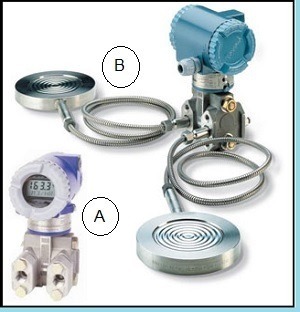
Protect your stress gauge, transmitters, and switches from excessive process temperature by installing the Sta-Kool Cooling Element earlier than the stress instrument. The Sta-Kool reduces the process temperature to extend the lifetime of the instrumentation. The Model SPT is a common purpose stress transducer with a compact design to suit into tight areas. This stress sensor has 316 stainless steel wetted parts to provide excellent media compatibility. The SPT is known for its stability within the subject, and is ideal for OEM functions. The DCT Pressure Sensor provides industrial and OEM clients glorious temperature stability and performance in a low price transducer.
A tire pressure gauge is an instance of gauge stress measurement; when it signifies zero, then the strain it's measuring is similar as the ambient stress. Pressure sensors may be categorized in terms of strain ranges they measure, temperature ranges of operation, and most importantly the kind of strain they measure. Pressure sensors are variously named in accordance with their objective, but the identical expertise could also be used underneath completely different names.
This is probably the most commonly employed sensing technology for common objective pressure measurement. Force collector typesThese forms of electronic stress sensors generally use a drive collector to measure pressure due to utilized drive over an area .
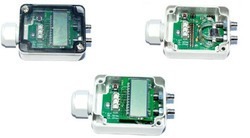
موجودی نمایندگی Festo ایران
Techniques include the use of the physical change of an optical fiber to detect strain because of utilized stress. This technology is employed in challenging applications the place the measurement may be highly remote, underneath excessive temperature, or might profit from applied sciences inherently immune to electromagnetic interference. Another analogous technique makes use of an elastic film constructed in layers that may change mirrored wavelengths based on the applied strain . Uses the piezoresistive impact of bonded or shaped strain gauges to detect pressure as a result of utilized pressure, resistance growing as stress deforms the material. Common know-how varieties are Silicon , Polysilicon Thin Film, Bonded Metal Foil, Thick Film, Silicon-on-Sapphire and Sputtered Thin Film. Generally, the strain gauges are connected to kind a Wheatstone bridge circuit to maximise the output of the sensor and to cut back sensitivity to errors.
KOBOLD and its affiliate firms have been and proceed to be leaders in the subject of business measuring and management equipment. Some of our products have set the bar within the business, helping to form the sphere of business instrumentation into what it is at present. Always on the vanguard, we offer a complete portfolio of reliable instrumentation that's present in a vast array of applications all around the world. Our applied sciences offer a solution oriented approach to control probably the most various variables.
A large number of completely different course of adaptations guarantee great flexibility with regard to set up in new crops and retrofitting in present processes, tanks or pipes. In addition to strain sensors with hygienic thread, tri-clamp connection and even O-ring seals, there are additionally variants that may be put in in pipelines with smallest nominal diameters from 1/4". Thanks to the two-point adjustment of zero level and span at any time, early alternative is avoided, thus considerably rising the service life.
The mounting position sometimes has some effect on the accuracy of the pressure transmitter. Most strain transmitters have a specification for the mounting position. Due to the extraordinarily secure and repeatable mechanical and thermal properties of fused quartz and the pressure balancing which eliminates most non-linear effects these sensors may be correct to round 1PPM of full scale. Due to the extremely nice fused quartz structures that are made by hand and require professional talent to assemble these sensors are generally limited to scientific and calibration functions.
1 note
·
View note
Text
Asia-Pacific Hygienic Point Level Sensor Market Research Report 2017 to 2022
Asia-Pacific Hygienic Point Level Sensor Market Research Report 2017 to 2022
MarketResearchNest.com adds “Asia-Pacific Hygienic Point Level Sensor Market Report 2017”new report to its research database. The report spread across 107 pages with table and figures in it. Geographically, this report split Asia-Pacific into several key Regions, with sales (K Units), revenue (Million USD), market share and growth rate of Hygienic Point Level Sensor for these regions, from 2012…
View On WordPress
#Hygienic Point Level Sensor#Hygienic Point Level Sensor Analysis#Hygienic Point Level Sensor Growth#Hygienic Point Level Sensor Industry#Hygienic Point Level Sensor Industry Trends#Hygienic Point Level Sensor Market#Hygienic Point Level Sensor Share#Hygienic Point Level Sensor Size#Hygienic Point Level Sensor Trends
0 notes
Text
Hygienic Point Level Sensor Market Report Types and Applications Trends 2032

The competitive analysis of the Hygienic Point Level Sensor Market offers a comprehensive examination of key market players. It encompasses detailed company profiles, insights into revenue distribution, innovations within their product portfolios, regional market presence, strategic development plans, pricing strategies, identified target markets, and immediate future initiatives of industry leaders. This section serves as a valuable resource for readers to understand the driving forces behind competition and what strategies can set them apart in capturing new target markets.
Market projections and forecasts are underpinned by extensive primary research, further validated through precise secondary research specific to the Hygienic Point Level Sensor Market. Our research analysts have dedicated substantial time and effort to curate essential industry insights from key industry participants, including Original Equipment Manufacturers (OEMs), top-tier suppliers, distributors, and relevant government entities.
Receive the FREE Sample Report of Hygienic Point Level Sensor Market Research Insights @ https://stringentdatalytics.com/sample-request/hygienic-point-level-sensor-market/1968/
The hygienic point level sensor market caters to industries where strict hygiene and sanitation standards are essential, such as food and beverage, pharmaceuticals, and biotechnology. These sensors are used to monitor and control the level of liquids, powders, or granular materials in tanks and vessels while maintaining cleanliness and compliance with industry regulations.
Report Consumption Analysis:
Consumption analysis in a market report for hygienic point level sensors typically includes data on the demand for these sensors across various industries. It may provide insights into factors driving consumption, such as increasing automation in food processing, the need for accurate level measurements, and regulatory requirements for hygiene and safety.
Key Vendors:
Key vendors in the hygienic point level sensor market are companies that manufacture and supply these sensors. Potential key vendors may include:
Endress+Hauser Group
VEGA Grieshaber KG
ABB Ltd.
Emerson Electric Co.
Siemens AG
Anderson-Negele
IFM Electronic GmbH
KROHNE Messtechnik GmbH The report may provide information on their market share, product portfolios, global presence, and strategic initiatives.
Market Segments:
Segmentation in the hygienic point level sensor market can be based on various criteria, including:
Industry Vertical: Different industries have unique requirements for hygienic point level sensors, such as dairy processing, pharmaceutical manufacturing, and brewing.
Type: Segmentation by sensor type, such as capacitive sensors, conductive sensors, or optical sensors.
Application: Different applications, including liquid level monitoring, interface detection, and powder level sensing, may require specialized sensors.
Business Overview:
This section of the report provides an overview of the current state of the hygienic point level sensor market. It may include information on market size, growth trends, competitive landscape, and key players. A SWOT analysis could highlight the strengths, weaknesses, opportunities, and threats in the market. Financial performance, recent developments, and growth strategies of key vendors might also be included.
Upcoming Trends:
The report may forecast or suggest potential upcoming trends in the hygienic point level sensor market. Some trends to watch for may include:
Industry 4.0 Integration: Integration of sensors into Industry 4.0 and smart manufacturing systems for real-time monitoring and data-driven decision-making.
IoT Connectivity: Use of IoT-enabled sensors for remote monitoring, predictive maintenance, and improved efficiency.
Hygienic Materials: Development of sensors made from materials that comply with strict hygiene standards and are resistant to corrosion and contamination.
Increased Automation: Growing adoption of automation in food and pharmaceutical production, driving the demand for precise and reliable level sensors.
Regulatory Compliance: Ongoing focus on compliance with hygiene and safety regulations, leading to the adoption of sensors that meet industry standards.
Customization: Demand for sensors tailored to specific industry requirements, leading to customized sensor solutions.
Key Benefits of Hygienic Point Level Sensors:
Improved Hygiene: Hygienic point level sensors are designed to meet stringent cleanliness standards, ensuring that they can be used in sanitary and sterile environments without introducing contaminants.
Enhanced Product Quality: These sensors help maintain consistent product quality by ensuring that tanks and vessels are filled to the correct level, preventing underfilling or overfilling.
Regulatory Compliance: They assist industries in complying with strict regulatory requirements related to hygiene and safety, reducing the risk of non-compliance fines.
Reduced Product Loss: Accurate level monitoring minimizes product wastage by preventing spills and overflows, leading to cost savings.
Process Efficiency: Automation and real-time monitoring enabled by these sensors improve process efficiency, reducing downtime and optimizing resource utilization.
Remote Monitoring: Many hygienic point level sensors offer remote monitoring capabilities, allowing operators to track levels and receive alerts from a distance, improving operational flexibility and responsiveness.
Market Segmentations:
Global Hygienic Point Level Sensor Market: By Company
• GHM Group
• Siemens
• Anderson-Negele
• SICK Vertriebs
• Petrotek
• Ferret
• Tempcon
• Hidroteka
• Baumer Group
• OMEGA Engineering
Global Hygienic Point Level Sensor Market: By Type
• Contact Type
• Non-contact Type
Global Hygienic Point Level Sensor Market: By Application
• Petrochemical
• Metallurgy
• Electricity
• Pharmaceuticals
• Others
Regional Analysis of Global Hygienic Point Level Sensor Market
All the regional segmentation has been studied based on recent and future trends, and the market is forecasted throughout the prediction period. The countries covered in the regional analysis of the Global Hygienic Point Level Sensor market report are U.S., Canada, and Mexico in North America, Germany, France, U.K., Russia, Italy, Spain, Turkey, Netherlands, Switzerland, Belgium, and Rest of Europe in Europe, Singapore, Malaysia, Australia, Thailand, Indonesia, Philippines, China, Japan, India, South Korea, Rest of Asia-Pacific (APAC) in the Asia-Pacific (APAC), Saudi Arabia, U.A.E, South Africa, Egypt, Israel, Rest of Middle East and Africa (MEA) as a part of Middle East and Africa (MEA), and Argentina, Brazil, and Rest of South America as part of South America.
Click to Purchase Hygienic Point Level Sensor Market Research Report @ https://stringentdatalytics.com/purchase/hygienic-point-level-sensor-market/1968/
Report includes Competitor's Landscape:
➊ Major trends and growth projections by region and country
➋ Key winning strategies followed by the competitors
➌ Who are the key competitors in this industry?
➍ What shall be the potential of this industry over the forecast tenure?
➎ What are the factors propelling the demand for the Hygienic Point Level Sensor?
➏ What are the opportunities that shall aid in significant proliferation of the market growth?
➐ What are the regional and country wise regulations that shall either hamper or boost the demand for Hygienic Point Level Sensor?
➑ How has the covid-19 impacted the growth of the market?
➒ Has the supply chain disruption caused changes in the entire value chain?
Customization of the Report:
This report can be customized to meet the client’s requirements. Please connect with our sales team ([email protected]), who will ensure that you get a report that suits your needs. You can also get in touch with our executives on +1 346 666 6655 to share your research requirements.
Enquiry Before Buying @ https://stringentdatalytics.com/inquiry/hygienic-point-level-sensor-market/1968/
About Stringent Datalytics
Stringent Datalytics offers both custom and syndicated market research reports. Custom market research reports are tailored to a specific client's needs and requirements. These reports provide unique insights into a particular industry or market segment and can help businesses make informed decisions about their strategies and operations.
Syndicated market research reports, on the other hand, are pre-existing reports that are available for purchase by multiple clients. These reports are often produced on a regular basis, such as annually or quarterly, and cover a broad range of industries and market segments. Syndicated reports provide clients with insights into industry trends, market sizes, and competitive landscapes. By offering both custom and syndicated reports, Stringent Datalytics can provide clients with a range of market research solutions that can be customized to their specific needs.
Reach US
Stringent Datalytics
+1 346 666 6655
Social Channels:
Linkedin | Facebook | Twitter | YouTube
0 notes
Text
Finding Best Electric Toothbrush Under $50

Literally hundreds of visitors to our website are looking for a toothbrush that doesn't cost the bomb.
They are looking for a Best Electric Toothbrush Under $50 and most importantly where to buy it?
The reasons are many. Some are first time buyers like you. While you do want to try out an electric toothbrush you are not willing to spend hundreds of dollars before you know for sure that electric toothbrush is something that you will use for the long term. You don't want it to be one of those expensive hobbies that you forgot about after one week.
You are in luck because on this website we have several models that cost you less than $50 dollars without any of the major functions missing. After all what is the point of owning an electric toothbrush if you can enjoy the better functionalities like inbuilt 2 minute timer or the pressure sensor that warns you if you are pressing too hard on your teeth.
Even if the money is tight at the moment, there is no need to compromise. Because there are several models that have outstanding features even in the lower price range. Our picks are some of the Best Electric Toothbrush Under $50 and yet there features can only be found in the more pricier, high end models. In fact it's a steal. The models that we have picked and their features make them absolutely top end but their prices are well within your reach.
How is it possible to get these fantastic features in models that cost less than $50? The reason is that top end toothbrush makers like Philips and Oral B know that there is a huge section of the population that still has not tried out an electric toothbrush. The people in this group are willing to try out a Best Electric Toothbrush Under $50. So the big manufacturers offer a taste of what's on offer in their higher end models with their entry level models priced at less than $50.
They may lack some features like more cleaning modes, adjustable intensity levels, extra brush heads, Bluetooth connectivity or feature to connect to an app to track your brushing performance. If you are in the market to try out an electric toothbrush and find out for yourself if it is something you will stick on for the long term, then lacking these extra features is not an issue.
Our handpicked list of Best Electric Toothbrush Under $50 includes toothbrushes from Philips, Oral B, Fairywill and more:
1. Philips Sonicare Essence
2. Oral-B 1000 CrossAction
3. Philips Sonicare ProtectiveClean 4100
4. Oral-B Pro 500
5. Philips Sonicare DailyClean 1100
6. BURST Sonic Electric Toothbrush
7. Fairywill Sonic Toothbrush
8. Oral-B Vitality Dual Clean
If you still have doubts that may be at $50 you can't really good electric toothbrushes. There is only one thing we can say. That yes, these models lack some fancy features that make the top end models expensive. But these Best Electric Toothbrush Under $50 are not in any way lacking in cleaning abilities or their ability to remove plaque which is the main reason to invest in an electric toothbrush.
While these electric toothbrushes don't provide same level of cleaning as a dental clinic at the dental office they offer almost similar levels of cleaning. Dentists are impressed with this and recommend the electric toothbrushes to their patients. With better dental hygiene the number of dental visits also come down. Maybe you don't have $800 to splurge on best toothbrush models but surely $200 or less for a family of 4 is affordable for most families to ensure better dental health.
The best electric toothbrush under $50 models picked and listed here offer the very best of cleaning and plaque removal. They have many great features too but not fancy features that you really don't need. You can feel the difference in cleaning levels within a few short weeks of brushing with Best Electric Toothbrush Under $50.
0 notes
Text
Arplis - News: Dorothy Hong for The Wall Street Journal
Douglas Gilman put a new designer kitchen in his Manhattan apartment last year with entertaining in mind. He placed the sleek marble-accented Dada kitchen, from Italy’s Molteni&C, at the center of the airy 2,800-square-foot home that he created from combining two adjacent units in a former West Village printing house. He figured it would give him easier access to his guests.
But the arrival of Covid-19 restrictions has meant much more cooking, and next to no entertaining, and it’s his high-tech German appliances that have come to the rescue, including an induction cooktop that can sense where he places a pan, and a speed oven that combines convection and microwave technology.
“My ovens are almost more advanced than my computer,” says the 39-year-old financial-services professional of his $30,000 set of appliances from Gaggenau, Miele, and the U.S. brand Sub-Zero.
Douglas Gilman chose a speed oven that combines convection and microwave technology.
Eating may still be analog, but kitchens have taken up residence in the digital age, as designers and appliance makers increasingly rely on a host of technological innovations to update the traditional tasks of cooking, storing and cleaning up. Kitchen-appliance categories haven’t changed much since the 1970s, when microwave ovens began appearing on ordinary countertops. But cameras, sensors, artificial intelligence and newfangled materials are now turning those appliances into ultrasophisticated hardware, while smart functions and connectivity are recasting the Cloud as the latest kitchen accessory.
Buyers of Miele’s new G7000 series dishwashers never have to worry about running out of detergent. When the machine runs low, a sensor prompts their smartphones to reorder the brand’s trademark detergent disk from the company’s online shop.
Meanwhile, Bosch, Miele’s competitor in the luxury dishwasher market, has introduced Zeolite, an alkaline mineral compound, in its new dishwasher series. Among other tasks, the compound helps plastic items dry more efficiently.
Mr. Gilman’s West Village dining room, just off the kitchen, has a high-tech LED fixture from Austria’s Kaia Lighting.
Elsewhere in the kitchen, cameras in refrigerators can be called up on smartphones, allowing you to look into your fridge from the grocery aisle to see what you need to buy. For European homeowners, Bosch’s new Cloud-accessing system has a fridge camera to suggest recipes based on what you already have on-hand.
As the pandemic draws new focus to the kitchen, with families forsaking frequent dinners out for daily home-cooked meals, players in the industry are noticing an uptake in sales—accompanied by a greater interest in high-tech options. Even induction stovetops, which can be a hard sell for gas-loving Americans, have seen demand rise by 35% in the U.S.
Appliance sales declined in the early months of the pandemic, but now “U.S. demand has really come back strong,” says Axel Kniehl, the executive director of sales and marketing for Miele. “Consumers can’t spend money on other things, so they have started renovating their kitchens.”
The Hecklers of Phoenix have a kitchen that features a sensor-equipped Miele coffee maker, lights controlled from a smartphone app and a Dekton composite countertop that resists heat, light and scratches. A nearby TV has the option of an app-created camouflage screen when not in use.
Steve Craft for The Wall Street Journal
Covid-19 is changing homeowners’ basic expectations for the kitchen, according to a new survey compiled by the National Kitchen and Bath Association. Companies are seeing soaring requests for items that help keep the cooking area more sanitized, such as touchless faucets and antimicrobial surfaces.
Kohler, the Wisconsin-based plumbing company that specializes in luxury finishes, says a majority of homeowners recently sampled are starting to regard the touchless faucets as must-haves. Kohler now combines voice automation with their touchless feature, allowing you to command your faucet to pour exact amounts of water. Homeowners can go so far as to customize voice orders by recipe. Daniel Markham, a Utah-based influencer who has Kohler faucets in his new home, shouts out “mac and cheese” for just the right amount of water for the recipe his family of five uses.
Benoît Favier, managing director of La Cornue, the French oven and stove maker based outside Paris known for its customizable luxury ranges, says he expects a 15% to 20% rise in sales in 2020. Mr. Favier says customers are increasingly interested in copper detailing, which is thought to have antimicrobial properties.
Earlier this year, at the height of the pandemic, La Cornue introduced the Château Suprême, an Art Deco-inspired upgrade on its traditional design. The unit allows homeowners to mix and match induction and gas burners with a teppanyaki plate and a walnut cutting board. Prices run as high as $165,000.
Thermador, the California-based luxury appliance brand, offers an extra-low simmering feature that, the company says, lets you melt chocolate on a paper plate. Thermador users can hook up all its appliances categories to the same app, which will alert you that the fridge door is open, let your preheat your oven, or adjust the temperature of your wine cabinet to accommodate an unusual varietal. On its high-tech to-do list: finding ways to digitalize its luxury gas stoves.
Designer-kitchen makers are also going high-tech. This year, Italy’s Boffi introduced its high-performance ceramic-like material, called MDI, which can be used for a range of kitchen surfaces, including countertops and filler space around appliances. Nonporous, as well as crack- and stain-resistant, it is much easier to clean, and therefore more hygienic. A high-tech alternative to other materials, such as stone and stainless steel, it has a grain-like finish that is soft to the touch.
The rise in outdoor cooking as safer for entertaining than closed spaces has companies investing in research into materials for planned outdoor-kitchen lines, say a handful of executives.
In a new smart home in Phoenix, Dean Heckler, a 47-year-old industrial designer, and his wife, Angela Heckler, a 35-year-old fundraising director and singer-songwriter, put their new high-tech kitchen, finished in early 2020, at the center of a long, glass-enclosed, open-plan living space.
The island—covered in Dekton, a high-tech mineral composite with a large quartz content—is outfitted with an induction stove that senses pan size and a downdraft vent system. All blend in so seamlessly that the unit looks like a dining table.
“You don’t notice the kitchen unless you’re using it,” says Cavin Costello, the couple’s architect. “But it still has all the firepower.”
The Hecklers spent about $125,000 on the kitchen, including nearly $4,000 on a built-in Miele coffee maker, with sensors that detect the height of the cup being filled. They planned their project with automation in mind, and everything from their irrigation system to their house locks and lights can be controlled by Apple HomeKit and Siri.
A high-tech standout: their Steinway piano, which can record Mrs. Heckler’s performances to an app, where her compositions can then be edited. It can also play on its own on command. “You can treat the piano like a HomePod,” says Mr. Heckler.
For a Wisconsin couple, who wanted the kitchen in their Maui vacation home to be modern but not complicated, an innovative element is used to accent traditional touches. The couple, working with Chicago designer Mick De Giulio, spent about $380,000 on the kitchen, which includes expensive wood detailing, mixing wenge and smoked-Eucalyptus veneers with solid Monkey Pod, a locally grown hardwood.
Mr. De Giulio designed the $12,000 LED light fixture to complement the various finishes. LED lighting was once too harsh, he says, but the latest generation “gives off a really nice light that is complementary to wood grains.”
The humble toaster got an upgrade last year from Revolution Cooking, a Massachusetts-based company whose touch-screen smart toaster uses a quick-heating alloy to flash-toast and evenly brown while holding in moisture.
Europeans in select markets can now buy a new countertop Bosch cooking appliance called the Cookit that uses sensors to perfect a range of cooking functions, from evenly reheating leftovers to searing a steak.
Miele has recently introduced a whole new kind of oven, called the Dialog Oven, which uses electromagnetic waves to cook closely placed foods with differing energy levels. The company likes to show off the technology by cooking a fish in a block of ice. The oven can cook a roast in an hour, while a nearby pan of vegetables stays al dente.
Up-to-date kitchen appliances are key in the latest home-sales market, says Michael Harper, an agent with Boston’s of MGS Group Real Estate. He says a suite of new Sub-Zero Wolf kitchen appliances is a star selling point for a single-family Back Bay townhouse that dates to the 1890s.
The four-bedroom, seven-bathroom home, which just underwent a gut renovation, has an asking price of $9.995 million. “Luxury buyers want what they want, and they want it now,” he says, of the turnkey kitchen, which has an island covered in Italian Paonazzo marble, with a honed finish meant to resist stains.
While the pandemic is boosting current sales, kitchen companies are looking to the future. Bosch is researching induction surfaces that may one day do away with stovetops entirely, letting you turn select surfaces into potential burners. Agrilution, a Miele subsidiary, is now marketing small vertical farm units, called Plantcubes, for growing herbs and greens.
Robotic devices already have a place in American kitchens thanks to iRobot, the Massachusetts company that introduced the robotic vacuum cleaner in 2002, and, a decade later, the robotic mop. (In Phoenix, the Hecklers, use the company’s latest vacuum model, the self-emptying Roomba s9 to help keep dog hair to a minimum.) Colin Angle, iRobot’s CEO, foresees kitchen robots will next be used to take care of other menial tasks, such as loading and unloading dishwashers.
Howie Choset, a professor of Robotics at Pittsburgh’s Carnegie Mellon University, has his doubts about humanoid robots as servants-of-the-future. But he does see a growing role for machine-learning technology to help out with cooking technique, citing a potential future smartphone app.
Prof. Choset, part of a team doing kitchen-related robotics research in conjunction with the Culinary Institute of America, believes the app may be only a year or two away.
He sees cooks perfecting their slicing, dicing, braising and basting, while the camera on their smartphone tracks their technique, and voice-equipped technology shouts out pointers—comparing their actions with those of an expert chef.
Back in his own kitchen, Prof. Choset says he is still working on the basics. “I just learned to cook oatmeal,” he says.
The post The Future of Kitchen Design Is Hands-Free and Smartphone-Activated appeared first on Real Estate News & Insights | realtor.com®.
#SmartHome #TheWallStreetJournal #Trends #Kitchen

Arplis - News
source https://arplis.com/blogs/news/dorothy-hong-for-the-wall-street-journal
0 notes
Text
Smart Plant-Based Food Packaging Market Analysis & Forecast with 2020
Global Smart Plant-based Food Packaging Market: Snapshot
The global smart plant-based food packaging market is expected to gain a lasting impetus with continuous research and development activities for promoting bioplastic innovation. The market could provide food packaging products that are favorable for the health of the planet and also keep ingredients fresh for a longer period of time. Smart plant-based food packaging is projected to revolutionize the way people utilize, store, and purchase groceries without worrying much about waste.
Leading players operating in the global smart plant-based food packaging market are foreseen to come up with new offerings that could not only improve the shelf life of various food products but also protect the ingredients from the damaging effects of their surroundings. Smart plant-based food packaging is predicted to ride on their enhanced and novel preservation properties for increasing its demand in the market. This could be due to the implementation of value-added oxygen barriers in bioplastic. A new type of green plastic is envisaged to take shape in the market with the combination of complex technologies such as nanoparticle components and biopolymers.
Request A Sample Copy Of The Report https://www.transparencymarketresearch.com/sample/sample.php?flag=S&rep_id=14936
The usage of sensors in smart plant-based food packaging could be a significant addition envisioned to up the demand in the market at a high rate. Such sensors could notify consumers when the food was sourced, its temperature, and also pH levels. Even seafood could be held inside smart plant-based food packaging with the introduction of pot and bottle type products. Furthermore, food manufacturers are forecasted to reduce their carbon footprint with the implementation of smart plant-based food packaging.
Food packaging is essential for containment of products, preservation and protection, to reduce food spoilage, eliminating the risk of adulteration and present food in a hygienic and aesthetically attractive way. According to the Agriculture and Food Organization, one third of the food in the world is wasted and most of this wasted food is generated by retailers and consumers who follow dates on packages and throw away edible food due to a label. Therefore, a project was initiated in order to develop plant-based bioplastic food packaging which increases the shelf life of food and the researchers also have formulated sensors that notify the consumers and retailers whether the food inside can be consumed or not.
These smart plant-based food packaging not only extend the life of the food product but also eliminates the need for environment-harming plastic. The smart plant-based food packaging market can be segmented on the basis of product type, material type and as per the region. On the basis of product type, the market is segmented into blow moulded, pot designed and others. On the basis of material type, it is divided into cellulose based film and blow moulded film. On the basis of region, the market is segmented into North America, Europe and the emerging countries of Asia Pacific.
Safety of food products has become a top priority of consumers on a global scale. Increasing awareness among the consumers regarding the environmental concerns and gradual change in buying habits is likely to propel the smart plant based food packaging market. Biodegradable plant based polymers in plant based food packaging is manufactured by cultivating carbohydrates via bacteria, while bio plant based polymers are macromolecules derived from plant residues. This provides the plant based food packaging improved food preservative properties. It is mainly designed to extend shelf life of the food and also to protect the contents from its surroundings. Standard packaging permits the entry of air which places limitations on shelf life of the food.
There is a lot of opportunity existing in the food packaging market in the developing economies as the food packaging technology is making huge progress in these regions. North America is leading the food packaging market followed by Asia Pacific and Europe. But somehow the growth rate shown in these regions have subsided considerably as the market is close to its peak. This growth is however restored by the high growth rate regions of Asia Pacifica which includes China, India and Latin America.
Smart plant based food packaging is one of the areas where food packaging companies can emphasize on refining their practices. Reutilizing in-house and using eco-friendly and/or recyclable packaging is another step, but making plant based material and packaging means using more biodegradable products. Heinz, Coca-Cola and SINTEF are the major companies participating in the movement towards the use of smart plant based food packaging. Coca-Cola uses Brazilian sugarcane but is also looking into other plant based materials. Currently all of the company’s bottles are made of fully recyclable plastic using bio-based products whereas SINTEF is now ready to present the first demonstration of packaging made from polyactic acid. The company has partnered with other collaborators like Logoplaste and Greek company Agro to develop plant based food packaging. Other food packaging companies need to find if they can alter their packaging necessities and fit plant based packaging material in their budget for which the USDA has proposed a loan guarantee program which will give these manufacturers easy access to loan and also cheaper interest rates in order to build a new plant.
The report offers a comprehensive evaluation of the market. It does so via in-depth qualitative insights, historical data, and verifiable projections about market size. The projections featured in the report have been derived using proven research methodologies and assumptions. By doing so, the research report serves as a repository of analysis and information for every facet of the market, including but not limited to: Regional markets, technology, types, and applications.
The study is a source of reliable data on:
Market segments and sub-segments
Market trends and dynamics
Supply and demand
Market size
Current trends/opportunities/challenges
Competitive landscape
Technological breakthroughs
Value chain and stakeholder analysis
The regional analysis covers:
North America (U.S. and Canada)
Latin America (Mexico, Brazil, Peru, Chile, and others)
Western Europe (Germany, U.K., France, Spain, Italy, Nordic countries, Belgium, Netherlands, Luxembourg)
Eastern Europe (Poland, Russia)
Asia Pacific (China, India, Japan, ASEAN, Australia and New Zealand)
Middle East and Africa (GCC, Southern Africa, North Africa)
The report has been compiled through extensive primary research (through interviews, surveys, and observations of seasoned analysts) and secondary research (which entails reputable paid sources, trade journals, and industry body databases). The report also features a complete qualitative and quantitative assessment by analyzing data gathered from industry analysts and market participants across key points in the industry’s value chain.
Request For Covid19 Impact Analysis https://www.transparencymarketresearch.com/sample/sample.php?flag=covid19&rep_id=14936
A separate analysis of prevailing trends in the parent market, macro- and micro-economic indicators, and regulations and mandates is included under the purview of the study. By doing so, the report projects the attractiveness of each major segment over the forecast period.
Highlights of the report:
A complete backdrop analysis, which includes an assessment of the parent market
Important changes in market dynamics
Market segmentation up to the second or third level
Historical, current, and projected size of the market from the standpoint of both value and volume
Reporting and evaluation of recent industry developments
Market shares and strategies of key players
Emerging niche segments and regional markets
An objective assessment of the trajectory of the market
Recommendations to companies for strengthening their foothold in the market
Note: Although care has been taken to maintain the highest levels of accuracy in TMR’s reports, recent market/vendor-specific changes may take time to reflect in the analysis.
This study by TMR is all-encompassing framework of the dynamics of the market. It mainly comprises critical assessment of consumers’ or customers’ journeys, current and emerging avenues, and strategic framework to enable CXOs take effective decisions.
Our key underpinning is the 4-Quadrant Framework EIRS that offers detailed visualization of four elements:
Customer Experience Maps
Insights and Tools based on data-driven research
Actionable Results to meet all the business priorities
Strategic Frameworks to boost the growth journey
The study strives to evaluate the current and future growth prospects, untapped avenues, factors shaping their revenue potential, and demand and consumption patterns in the global market by breaking it into region-wise assessment.
The following regional segments are covered comprehensively:
North America
Asia Pacific
Europe
Latin America
The Middle East and Africa
The EIRS quadrant framework in the report sums up our wide spectrum of data-driven research and advisory for CXOs to help them make better decisions for their businesses and stay as leaders.
Below is a snapshot of these quadrants.
1. Customer Experience Map
The study offers an in-depth assessment of various customers’ journeys pertinent to the market and its segments. It offers various customer impressions about the products and service use. The analysis takes a closer look at their pain points and fears across various customer touchpoints. The consultation and business intelligence solutions will help interested stakeholders, including CXOs, define customer experience maps tailored to their needs. This will help them aim at boosting customer engagement with their brands.
2. Insights and Tools
The various insights in the study are based on elaborate cycles of primary and secondary research the analysts engage with during the course of research. The analysts and expert advisors at TMR adopt industry-wide, quantitative customer insights tools and market projection methodologies to arrive at results, which makes them reliable. The study not just offers estimations and projections, but also an uncluttered evaluation of these figures on the market dynamics. These insights merge data-driven research framework with qualitative consultations for business owners, CXOs, policy makers, and investors. The insights will also help their customers overcome their fears.
3. Actionable Results
The findings presented in this study by TMR are an indispensable guide for meeting all business priorities, including mission-critical ones. The results when implemented have shown tangible benefits to business stakeholders and industry entities to boost their performance. The results are tailored to fit the individual strategic framework. The study also illustrates some of the recent case studies on solving various problems by companies they faced in their consolidation journey.
4. Strategic Frameworks
The study equips businesses and anyone interested in the market to frame broad strategic frameworks. This has become more important than ever, given the current uncertainty due to COVID-19. The study deliberates on consultations to overcome various such past disruptions and foresees new ones to boost the preparedness. The frameworks help businesses plan their strategic alignments for recovery from such disruptive trends. Further, analysts at TMR helps you break down the complex scenario and bring resiliency in uncertain times.
You May Also Like PRNewswire on
https://www.prnewswire.com/news-releases/sake-brewery-industry-to-play-a-positive-role-in-cubitainers-market-growth-from-2020-to-2028-transparency-market-research-301104740.html
You May Also Like PRNewswire on
https://www.prnewswire.com/news-releases/penetration-of-advanced-technologies-to-bring-a-paradigm-shift-in-growth-of-warranty-management-system-market-north-america-to-add-numerous-feathers-of-growth-opines-tmr-301110185.html
The report sheds light on various aspects and answers pertinent questions on the market. Some of the important ones are:
1. What can be the best investment choices for venturing into new product and service lines?
2. What value propositions should businesses aim at while making new research and development funding?
3. Which regulations will be most helpful for stakeholders to boost their supply chain network?
4. Which regions might see the demand maturing in certain segments in near future?
5. What are the some of the best cost optimization strategies with vendors that some well-entrenched players have gained success with?
6. Which are the key perspectives that the C-suite are leveraging to move businesses to new growth trajectory?
7. Which government regulations might challenge the status of key regional markets?
8. How will the emerging political and economic scenario affect opportunities in key growth areas?
9. What are some of the value-grab opportunities in various segments?
10. What will be the barrier to entry for new players in the market?
0 notes
Text
The 5-Second Trick For Mobile Graph Game.
Incorporate and ADHD. These hyperactivity Ailments are remarkably typical amongst video clip recreation addicts due to higher interactivity levels of a lot of now’s online video games.
Neglect in personalized hygiene. Individuals addicted to online video online games are inclined to care a lot less regarding their hygiene considering that they invest significantly less time in social settings plus more time on your own taking part in games.
https://www.graphgame-ko.com/
https://www.graphgame-ko.com
www.graphgame-ko.com
그래프게임사이트 바로가기
Quettra Mobile Intelligence mobile app data is utilized to map out a normal retention curve for Android apps below – which displays to some degree much less generous benefits than Those people noticed earlier mentioned.
We'd Take note that new application obtain stats are completed dominated by Google Perform downloads. For the new application developer running internationally, it would be more practical to focus on Android than iOS devices (with regard to growth, not Probably income).
The full range of apps during the Google Participate in Retailer fell after that point, getting a nosedive in the 2nd 50 percent of 2018 to The existing stage.
While there may be audio logic in this, we may additionally consider the potential for an progressively mature mobile gaming landscape; and distinctions involving markets. Most likely in less experienced markets, game titles will have a much better hold through the center and afterwards levels of maturity.
Outside of this podium, the reduce we go, the much less applications we find. Curiously, we see the greatest average variety of opinions for apps in the higher echelons in rankings terms, with apps rated four.
Obviously, as we noticed over, all game titles aren't manufactured equivalent – and we would Be aware that some genres fare far far better concerning retention than Other people.
Sensor Tower notes that 2018 was a highly-profitable calendar year for activity developer Voodoo, which accounts for 1 / 4 of the best-twenty most-common new online games right here – together with Helix Jump
Candy Crush is psychologically appealing to gamers since the recreation releases new amounts every single week, forces players to await life to refill, and offers players the choice to acquire new life and boosters by click here using a handful of uncomplicated clicks.
Here’s an in depth check out mobile activity addiction, how developers hold you hooked, and what you are able to do to forestall mobile sport dependancy from getting to be a problem in the first place.
Growing mobile gaming audiences current advertisers with enormous possibility—comprehension the best way to very best attain these different and distinctive demographics will in the end assistance advertisers craft A prosperous influencer advertising and marketing method.
China is available in past regarding both video games put in and used. We might note, having said that, that the figure would Potentially be better if we only took into account hugely-formulated ‘tier-one’ metropolitan areas.
in Japan. Even though struggle royale video games may possibly get many the push, it’s these simpler titles to which the common mobile consumer the world over is turning.

0 notes
Text
As Toilet Paper Stock Plunges, Bidets Are Making a Splash
Manufacturers say bidet sales have gone up “ten times” since news of the coronavirus broke
Originally published on rollingstone.com by Tim Chan On March 19, 2020

Shutterstock / Aleksey Kurguzov
Products featured are independently selected by our editorial team and we may earn a commission from purchases made from our links; the retailer may also receive certain auditable data for accounting purposes.
As new cases of coronavirus continue to climb, so does the panic apparently, over hoarding household goods and supplies — especially toilet paper. By now, we’ve all seen the photos of empty store shelves and the viral videos of people fighting over the last rolls of bathroom tissue (bath tissue!). But while staking a line at your nearest Trader Joe’s or placing a bulk order on Amazon is one way to replenish your stock, the best way to combat that toilet paper shortage might be skipping the TP altogether and backing up to the old-school appeal of a bidet.
According to research firm, BRG, the overall bidet market has seen a “13 percent lift” over the last few years, and it’s only picked up since the COVID-19 outbreak. James Walsh, the Vice-President of Product Marketing at bathroom fixtures brand, American Standard, says “Orders for manual bidet seats have increased to five times more than the monthly average, while entry-level electronic bidet seats increased by three times the monthly average.” American Standard also saw a 168% increase in website traffic to its SpaLet pages over the previous week.
Meantime, Jason Ojalvo, CEO of the bathroom brand, TUSHY, says sales of the brand’s bidets have grown “from double to triple to 10 times” what they were just a few short weeks ago, after fears over the coronavirus caused a toilet paper-buying frenzy. With toilet paper in short supply, “This could be the tipping point that finally gets Americans to adopt the bidet,” Ojalvo says.
Bidets are common fixtures in many European bathrooms and bougie Japanese versions go for hundreds of dollars online, but the washing basin has been slower to be adopted on this side of the oceans. Essentially a large bowl that uses a gentle stream of water to clean out your backside, traditional bidets were separate units that typically sat next to a toilet in the bathroom. These days, a number of companies have introduced clip-in bidets or bidet attachments that are either affixed next to the toilet seat or can be part of the seat itself (the attachments are easily removable too). So-called “smart toilets” — essentially a bidet-toilet hybrid — also work, by combining both functions in one.
The team behind TUSHY says you’ll use “80% less toilet paper” with the addition of a bidet (you still need to pat yourself dry after using, though you can easily swap toilet paper for a hand towel or something similar). And considering Americans use more than 36 billion rolls of toilet paper every year — resulting in the loss of 15 million trees — bidets could go a long way toward not only saving our sanity during this toilet paper shortage, but also saving precious natural resources for generations to come.
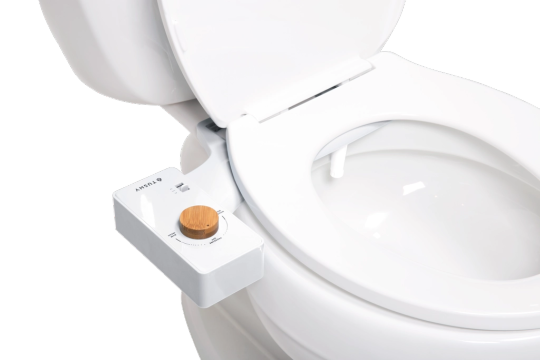
Courtesy TUSHY
TUSHY Classic Bidet Attachment, $79
Omigo’s “Element” bidet attachment uses dedicated rear and front nozzles for a more thorough clean. With the Element, like most bidet attachments, no electricity or power is needed, so it won’t take a swipe at your energy bills. Omigo calls their line of bidets a “clean and green solution to rethinking hygiene.”

Courtesy Omigo
Omigo Non-Electric Bidet Attachment, $71
Aside from easing our reliance on toilet paper and electricity, switching to a bidet may also be better for health and hygiene. According to Dr. Alex You, an L.A.-based emergency physician, bidets are more effective than regular TP because they use pressure and water. “If you have dirt on your hands you would want to use water [too] and not just wipe it on a paper towel right?” he asks. “Using toilet paper alone just wipes and smears your poop.”
“Health-wise, using a bidet is also important because many diseases, including things like hepatitis and potentially COVID-19 can be transmitted through fecal oral transmission,” You says. “Also, its just good hygiene.”
According to the team at TUSHY, wiping with dry paper or wet wipes contributes to “30 million annual cases of hemorrhoids, UTIs, yeast infections, anal fissures and itching.” So, you know: not great.
Frankly, a bidet also just feels damn good around your under-carriage. The stream of water gently caresses your nooks and crannies without being invasive. And it’s a whole lot easier than trying to slide in there with TP alone. In just a few seconds, you’ll have cleaner cheeks and a more refreshed rear end.
If there’s a crack against using a bidet, it’s that the device isn’t super portable. But many companies — including TUSHY — have introduced travel-sized bidets, that utilize an angled nozzle and squeeze bottle to get the job done. As for the myth that a bidet recycles your toilet water? Consider that fake news.
“‘Isn’t it dirty toilet water you’re spraying your butt with?’ is a myth we often hear,” says Ojalvo. “[but] the bidet uses the same water in your bathroom that you use to brush your teeth — the water comes from behind the wall, not your toilet.”
When it comes to personal hygiene, there isn’t a one-swipe-fits-all solution, but as toilet paper shortages continue, expect bidet sales to continue to rise.
“Even though they are not a staple in every Americans’ home and business, there has been a bidet buzz for years now,” says Walsh. “People are looking for convenient, sustainable solutions for health and wellness in their everyday life and bidets answer that need.”
“The reality is, once you use a bidet to clean after pooping you cannot go back to wiping and toilet paper,” Ojalvo says. “Wiping seems not just inefficient, but also barbaric, by comparison.”
1. TUSHY Classic Bidet Toilet Attachment
The team behind TUSHY says you’ll use “80% less toilet paper” with the addition of a bidet (you still need to pat yourself dry after using, though you can easily swap toilet paper for a hand towel or something similar). And considering Americans use more than 36 billion rolls of toilet paper every year — resulting in the loss of 15 million trees — bidets could go a long way to saving precious natural resources for generations to come.
This bidet attachment installs in ten minutes and doesn’t require any electricity or additional plumbing. To use: turn the knob to set the nozzle spray. Adjust intensity and duration as necessary.
PROS: Easy to use. Self-cleaning nozzle keeps things hygienic.
CONS: The TUSHY frame is squared-off, not rounded like your toilet bowl, so it can stick out a little. Single temperature only though the TUSHY Spa model lets you use warm water.
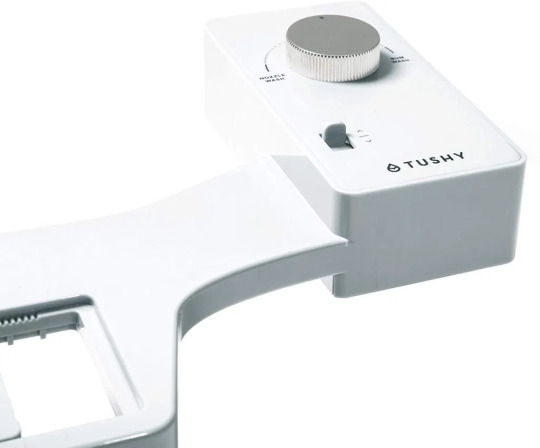
Courtesy Amazon
Amazon
Buy: TUSHY Classic Bidet Toilet Attachment $79.00
BUY IT
2. SmartBidet SB-1000 Electric Bidet Seat
Swap your basic toilet seat for this electric bidet seat from SmartBidet. The seat is easy to install yourself (no need to hire a plumber) and accommodates up to 440 pounds in weight.
A built-in “skin sensor” activates the seat when you sit down. Use the included remote control to cycle through five different water pressure levels, three different water temperatures and five different nozzle positions. The nozzle can be used for a “posterior wash” or for a “feminine wash” as well. The “turbo wash” gives you a more invigorating clean.
A built-in warm dryer lets you finish off without needing to reach for toilet paper.
PROS: Built-in dryer saves need for toilet paper. A heated seat and different temperature modes provide a more comfortable experience.
CONS: Requires an electrical outlet.
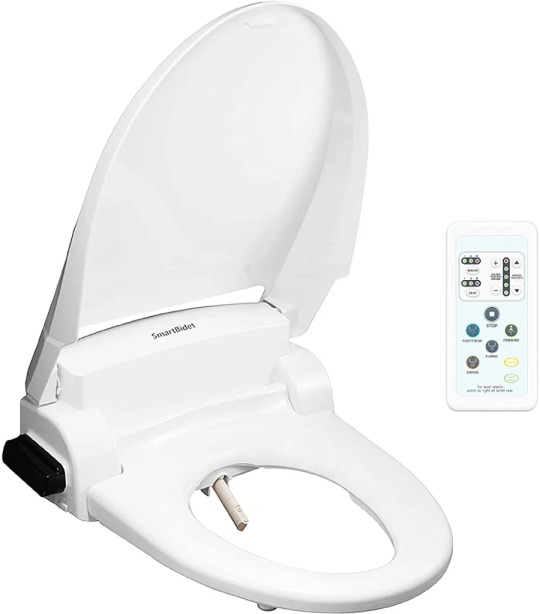
Courtesy Amazon
Amazon
Buy: SmartBidet SB-1000 Electric Bidet Seat $249.99
BUY IT
3. Luxe Bidet Mechanical Bidet Attachment
The Luxe Bidet Neo 120 is a simple, no-fuss bidet that uses fresh water and a powerful nozzle to give you a thorough, targeted clean.
Turn one of the chrome knobs to “wash,” and then use the other knob to select your desired water pressure.
What we like: a hygienic “nozzle guard gate” shields the nozzle to prevent unwanted (or unsightly) splashes. The nozzle automatically retracts behind the guard gate after each wash. The nozzle is self-cleaning.
The Neo 120 is easy to install and attaches to most standard toilets. Its slim, low-profile design doesn’t take up too much room.
PROS: Sleek, unobtrusive design. Steel hoses instead of cheaper plastic ones.
CONS: Cold water only. Nozzle not as intuitive or customizable as other units on this list.
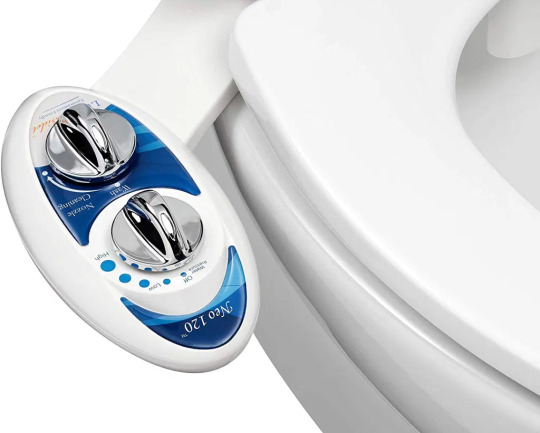
Courtesy Amazon
Amazon
Buy: Luxe Bidet Mechanical Bidet Attachment $35.99
BUY IT
4. Brondell GoSpa Travel Bidet
A discreet, convenient solution, this GoSpa travel bidet uses a simple squeeze bottle design and spray nozzle to keep you clean on the go.
The bottle holds up to 400ml of water (fill it with cold or hot water) and an air lock on the bottle allows a little air to seep in, so the bidet doesn’t overspray. To use: angle the nozzle arm under your body and gently squeeze the bottle.
This set comes with a drawstring travel bag for easy storage.
PROS: Because you fill the bottle yourself, consider adding some essential oils to your water to create your own cleaning solution.
CONS: Squeeze bottle is quite sensitive so press gently.
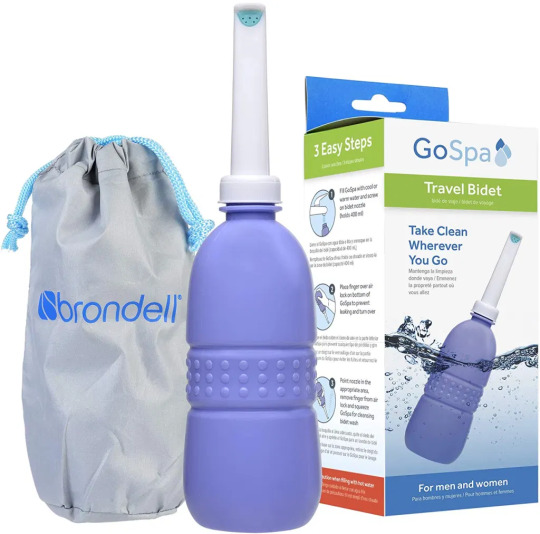
Courtesy Amazon
Amazon
Buy: Brondell GoSpa Travel Bidet $9.98
BUY IT
5. TOTO C200 Washlet
TOTO takes the throne when it comes to bidets, and their popular Washlet model doubles down on thoughtful details for a cleaner, more comfortable experience.
The first thing you’ll notice is that the lid automatically opens and closes when it senses movement nearby. A “pre-mist” function sprays the inside of the toilet bowl before you sit down, to both clean and also prevent waste from sticking. The self-cleaning wand, meantime, is automatically cleaned inside and out before and after use.
The Washlet features a heated seat and both front and rear cleaning functions. You can also choose from five different temperature and pressure settings. Once you’re done, turn on the warm air dryer to finish off. A built-in air deodorizer removes any lingering germs or smells.
What we like: TOTO says its “AIR-IN WONDER WAVE” technology delivers a more effective and efficient clean. The reason: air is injected into the water, to enlarge the droplets, allowing the spray to cover more surface space without being too aggressive.
PROS: Chic, Japanese-inspired design with intuitive functionality.
CONS: Takes a little bit of time to install.
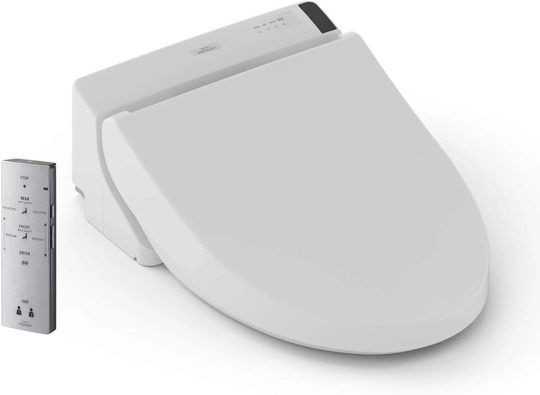
Courtesy Amazon
Amazon
Buy: TOTO C200 Washlet $425.78
BUY IT
Tushy was Founded by Miki Agarwal in 2015.
0 notes
Text
Hygienic Point Level Sensor Market

#Hygienic Point Level Sensor Market#us Hygienic Point Level Sensor Market#uk Hygienic Point Level Sensor Market#japan Hygienic Point Level Sensor Market
0 notes
Text
The Next Idea Restaurant and Food Forecast for 2019
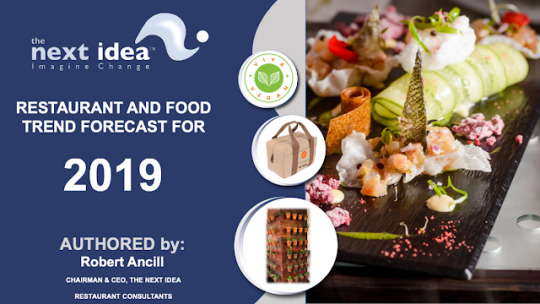
The Next Idea (TNI) anticipates 2019 to be a uniquely pivotal year as the restaurant and food terrain adjusts itself towards an increasingly confident, exploratory, and discerning consumer.
As we enter 2019 our world is uncertain; Brexit, trade wars, volatile US political landscape, populism, global warming, rising world population, and so it goes on. This may seem a disconnect from 2019 eating out trends, but in reality, our Planet and all of its transformations will have a significant impact on how we eat.
It is clear to most that the impact on our food eco-system by Earth’s planetary changes are significant; many factors involving farming methods, where food is grown, the deployment of pesticides and fertilizers, livestock feed, and so on, affect the environmental impact of the food we buy and eat. The significant changes in weather patterns, population, and geo-politics is now impacting what we eat; and this theme will transcend the coming years.
For example; approximately 86% of world food consumption is generated from rice, maize, sugar, wheat, barley, soy, palm and potato. Across the globe diets are actually becoming increasingly similar, both in the food types, and also the varieties of those food types that are consumed. This results in increasing exposure to shortages in the event of a large-scale natural disaster. For example, food shortages in 2007/8 were caused by a yield loss in Australia of less than 1% of global food supply, however the net effect created spikes in food pricing and political unrest in certain parts of the world. As economists tried to make sense of the problem, the one primary metric was obvious: world population growth [Demand] vs shrunken availability [Supply] was out of balance.Combine the world’s macro issues at localized levels and we begin to see shifting and emerging trends in both food production and consumer demand.
Talking of the consumer, what are the 2019 consumer’s expectations? This is of course deeply complex and fluctuates by age, income and demographic, however one theme appears to have emerged since the great recession – consumers want a relationship not a transaction. They covet their chosen brands that leverage situational and behavioral data as the primary foundation of their brand engagement. But it goes further, consumers expect their brand experience to be seamless across all engagement points and when it fails, which is inevitable at some stage, recovery will be based on the quality and speed of service and ability to address whatever the failure may be.
When it comes to food and restaurants, consumer expectations have never been higher. With the ability to post their feedback on Trip Advisor, Yelp and Zomato, to name a few, consumers have immense power over brands to ensure they comply, and in some cases exceed, their promise. Indeed, consumers have an unprecedented ability to access or experience food and restaurant products and share this information via all social media platforms.
The modern 2019 consumer has a set of 6 primary values when it comes to food; summarized as follows:
Health Awareness
Transparency
Sustainability
Social Consciousness
Trust & Honesty
Technology Integration
The above value structure is defining trends and demand, accelerating disruption throughout the food chain, and creating a new environment for food sellers and restaurant operators to acclimate their business models.
Evaluating further, the following summarizes each consumer value:
Health Aware
Health continues to be the primary propelling consumer value. When glancing ahead into 2019, expect consumer health and wellness targets to reach new levels. Consumers are increasingly treating their bodies like ecosystems, understanding nutrition valuations and how different foods affect them. They are even customizing their diet based on DNA and Genetics. Food is increasingly viewed as nutritional therapy for all consumer types.
Transparency
TNI has reported on the change in Consumer behavior since the great recession in 2008/9, whereby demand for honesty and transparency was fueled by perceived brand and corporate deceitfulness. Since then, this value has permeated throughout the food & restaurant world with consumers requiring guarantees on food hygiene, ethics, labelling, and sustainability standards. Traceability from farm to fork, through labelling and general information, is a significant demand by the consumer, and has forced a democratization of both nutritional data and overall ingredient history.
Sustainability
Sustainability has become a major consumer concern over the past twenty years, but never more than now. After experiencing the effects of global warming in 2018 and hearing major scientific reports coming from the United Nations, consumers are acutely aware of their individual impact on Planet Earth, and what the future might look like should they not act.
From the enhanced management of waste reduction, through to renewable packaging in materials and shorter food supply chains, consumers are placing increasing demand on food producers and restaurants to act in the interest of the environment.
Social Consciousness
Consumers now care; it’s that simple. Consumers want to know what supermarkets are doing with their wasted food, how each restaurant supports the community they serve, and how their dollar will be used to support worthwhile causes. This especially applies to the millennial population who demand socially aware food and restaurant brands, or they shop and eat elsewhere.
Trust & Honesty
Consumers are increasingly wary of corporate America, whom they believe have no incentive to act in the consumer’s best interest. Consumers are increasingly fact checking the corporations they choose to do business with. Equally, consumers’ brand loyalty is switching from household names to local and small businesses whom they can better relate to.
Honesty is not just about businesses being truthful, it’s a devotion to genuineness that the consumer seeks: Brands that talk about their roots, and demonstrate their commitments through social responsibility policies, are on trend in 2019.
Technology Integration
Technology within food and food service is not new and the app-centric global society is being serviced well by technology availability. However, technology is becoming increasingly sophisticated and advanced. Artificial Intelligence is being introduced throughout food service and provides predictive technology for restaurant food ordering. Technology runs deep into all forms of food production given the vulnerabilities in farming due to climate change. New blockchain technologies will allow farming to move into warehouses and even underground, through the availability of open source hardware and software platforms for sensor controlled hydroponic and aeroponic agricultural systems. Consumers are welcoming these technologies and availability as it speaks to their interest in sustainability, and in many cases provides something to talk about on social media.
Trend changes in the Food and Restaurant market
The market is changing at unprecedented velocity, this is demonstrated by the multiple emerging trends within all markets. Veganism, *Entomophagy, Lab grown meat, 3d food printing, Food being Medicine, CBD and THC infused products, Nut and grain-based milks, Drone and self- driving car delivery, street food innovation, and the regeneration of food waste, represent the major trends that will prevail through 2019 and after. In the main, these trends will circle around a major theme in food trends over the past 20 years; Health!
THE CONSUMER?
Indeed, it is the consumer that will be 2019’s champion for change as, through their combined buying and social media sovereignty, the consumer’s voice will be more powerful than ever.
So, this elusive consumer, what do they actually want? Well, naturally not all consumers are made the same; age, ethnicity, income, and overall demographics all share their role in segmentation. With that said, today’s consumers possess one value that they increasingly collectively care about, and that is their health. While it may seem obvious, consumer health is one of the primary drivers in emerging and materialized food trends, and it is igniting a full array of sub-trends that form 2019’s food and restaurant trend roadmap.
HEALTH LEADS FOOD DECISIONS
Of course, healthy eating is not a new trend, but the rapidity at which consumer eating habits have shifted towards healthier eating represents the difference. Both at home and in restaurants, consumer food choice has migrated with a greater emphasis on ‘clean’ and ‘healthy’ dishes and is metamorphizing the eating out landscape at an extraordinary rate.
Historically, ‘healthy eating’ was limited in options and generally considered a less than favorable culinary experience. However today, consumers have a far more informed opinion and choice when it comes to ‘healthy food’ options. This is generally due to the swath of cooking channels along with the exponential increase in digital and social media engagement, and creative chefs who have made health food look enticing and fun.
Putting this into perspective, the global health and wellness food market was valued at 707.12 billion U.S. dollars in 2016 and projected to increase up to 811.82 trillion U.S. dollars by 2021. Organic food is another example: The U.S. organic food market size is expected to reach 70.4 billion U.S. dollars by 2025 as a result of increasing demand from consumers.
Organic food is another example: The U.S. organic food market size is expected to reach USD 70.4 billion by 2025 as a result of increasing demand from consumers.
Combined with intensified interest in global flavors, superfood ingredients, and Instagram-ready dishes, retail food ranges and restaurant menus will increase focus on dietary needs and concerns while elevating innovation using foods from the past.
PRIMARY 2019 FOOD TREND THEMES
As we head into 2019, there are eight primary themes when establishing 2019’s food trends:
Veganism
Food as Medicine
Entomophagy
CBD and THC infused products
Milk is not Milk
Food delivery
Regeneration of food waste
Technology
These themes relate to all future food trends, in some cases at multiple levels, and as such are the foundation to current and future trends.
2019 Food and Restaurant Trends
Vegan

Not even ten years ago, vegan cuisine was generally considered fodder for hippies, yet in 2019 it is undoubtedly the prevailing overall culinary trend in the US.
The Vegan landscape now includes established restaurant brands; Veggie Grill, Amy’s, Native Foods, Southern California-based Plant Power, and recently re-named Viva Vegan, to name a few. All have all demonstrated the power of this trend and are experiencing above average market growth.
However, the carnivore brands are fast jumping on the bandwagon; Carl’s Jr. announced it was launching a burger made with a Beyond Meat [vegan] quarter-pound patty. White Castle now sells its plant based Impossible Sliders in all of its 377 locations, Del Taco has expanded its Beyond Taco trial to over 20 of its locations, and McDonald’s has been introducing a Vegan burger in its international markets and is eyeing the US market to launch in 2019.
This trend has been fueled by consumers eating less red meat combined with the discernible health benefits and product innovation. What is interesting is that there is not necessarily a significantly elevated vegan population, instead there is a new consumer breed widely known as a flexitarian.
The label ‘flexitarian’ has been applied to the consumer group who purposefully interchanges between eating meat and vegan foods.
In order to be familiar; vegan restaurant and food brands are taking traditionally meat-based products, such as burgers, pizza, and tacos, and converting them into a plant-based alternative.
Take *Viva Vegan’s menu for example. They offer a Famous Works Burger, a blend of 27 plant-based ingredients, and spaghetti and meatballs, which includes gluten and soy free pasta with bean and grain-based meatballs with a plant-based sauce.
Some Statistics
In the USA there has been a 600% increase in people claiming to be vegans in the last three years. In 2014, 1% of U.S. consumers professed to be vegan in 2014 whereas in 2017, that number rose to 6%.
Source: Global Data
Google Trends details worldwide increase in the interest in veganism from 2004 to 2018. Seven percent or about 3.5 million people now identify as vegan in Great Britain. The U.S. and U.K. round out the top 2 vegan countries by percentage, India takes the first spot with veganism encompassing 27% of the population.
Google Search reports that veganism is now experiencing virtually 3 times more interest than vegetarian and gluten free searches.
A study by Oxford Martin School, (part of Oxford University), stated: ‘A global switch to diets that rely less on meat and more on fruit and vegetables could save up to 8 million lives by 2050, reduce greenhouse gas emissions by two thirds, and lead to healthcare-related savings and avoided climate damages of $1.5 trillion (US)’.
Technomic reports that 50% of operators are embracing plant-based eating trends when developing new menu items.
Of course, given TNI is a Los Angeles based agency, it would be amiss if we didn’t discuss our Hollywood friends – Ariana Grande, Zac Efron, Gisele, Ellie Goulding, Natalie Portman, Daryl Hannah, Woody Harrelson, and mega star, Beyonce, are all self-declared Vegans.
The Future...
Veganism will grow exponentially. For example, the *global meat substitutes market is expected to generate in excess of $5bn in revenue, representing compound annual growth (CAG) rate of 8.4% between 2015-2020. ** Vegan Cheese has forecasted global sales of around $4bn by 2024, a CAG of 7.6% from 2016 to 2024.
Expect vegetable versions of kung pao chicken, charcuterie, cured heirloom carrots, sushi, tacos, and even steak.
Food as Medicine

We are what we eat – and consumers now know this! The Food as Medicine philosophy aims to manage or even cure chronic illness by changing what people consume. Nielsen reported in 2018 that 39% of American households have someone who suffers from a particular ailment. The US aging population is increasing, chronic diseases will only grow in the coming years. However, rather than relying 100% on prescription and over-the-counter medicines, a growing base is looking at natural remedies that include very precise culinary diets and nutrition plans.
The food as medicine trend derives from consumers taking greater personal responsibility for their own health and wellness. Food production and food service industries have responded favorably by providing healthy and sustainable food that has made the healthier food choice the easiest one. For example, Hormel and Nestle have both announced their intent to develop nutritional products that will help their customers manage any personal ailments. AREEA, a biotechnology business, has produced a ready to drink beverage containing an enzyme that detoxes the body from daily pollution effects. In January 2019,Phood Farmacy, a brand committed to food as medicine launches its first virtual kitchen in North Hollywood, California. Phood Farmacy offers a spectrum of exciting yet nutritionally infused meals in addition to specific medical condition-based meal plans. All meals are made from clean ingredients combined with comprehensive nutritional planning.
“Naturally Functional” is a new buzzword behind the success of many foods now known as “Super Foods” such as blueberries, pomegranate, chia seeds and goji berries, to name a few. This endorses consumers search for foods and ingredients that they perceive as naturally healthy and provide essential health benefits.
Food education and mindfulness have become growth trends for 2019, mainly through the accessibility of information, but also through food hubs and online communities such as Food + Tech connect, and the Food Tank. Thus, consumers now understand the nutritional value of natural food ingredients and how each ingredient reacts with themselves specifically; consequently, they are seeking out specific ingredients to assist in their personal wellness and being.
The concept of Food as Medicine will permeate throughout the industry as consumers, therapists, and doctors increasingly appreciate the relationship between food intake and wellness.
We should expect to see prescriptions of specific diets of foods and recipes that enhance the healing process, elevate immunity, and address specific medical conditions with patients.


Examples of high value foods include:
Kelp: Rich in calcium, magnesium, potassium, and iodine – helps keep thyroid levels balanced
Shiitake mushrooms: Contains lentinan which may fight cancer and slow tumor growth
Moringa: Possesses powerful anti-inflammatory, antioxidant, and tissue-protective properties
Rooibos tea: Contains antioxidants that can protect against cancer, heart disease and stroke
Garlic: Rich in vitamin C, B6 and manganese, supports the heart and reduces blood pressure
Ginger: Anti-inflammatory and antioxidant properties
Basil: Contains eugenol, keeps intestines safe
Many “medicinal” foods such as apple cider vinegar, kefir, and turmeric are now mainstream. This trend is young; many more foods will reach the forefront as consumers seek out natural remedies for conditions like inflammation, fatigue, digestive issues, joint pain, depression and the multitude of other medical conditions that can be supported by a specific mix of foods and natural supplements.
Entomophagy,consumption of insects

As the planet journeys towards a population of 9 billion people, the food industry is driven to unearth new and sustainable food sources. Insects represent a relatively untapped food-type in the west yet are established in diets or snack culture in other parts of the world. For example, in parts of central Africa, around 50% of protein is derived from insects. During the springtime in Ghana, when food is scarce, Ghanaians rely on termites as their main source of protein. Thailand’s popular Jing Leed is deep-fried crickets with a soy based dipping sauce. Thais also love snacking on grasshoppers, crickets and woodworms. In Mexico, chicatanas, or pan-roasted ants with lime, are as mainstream as tacos. Edible insects contain high quality protein, amino acids and vitamins, and even mass consumption has a small impact environmentally.
Companies like Entocube provide technology to farm insects and process them as an ingredient to the food industry and Bugsolutley produces cricket-based pasta. Presently, crickets are the most common insect type being used in the US. Mainly for the production of cricket flour and protein products. However other insect types are also expected to become available, including caterpillars, different beetle species, and larvae. Even termites are under experimentation.
In the US, Meat Maniac, a Texas based company, provides a broad range of insect based snacks, such as: hot Mealworms, Emperor Scorpions and Earthworm Jerky. The entomophagy trend is still in its infancy in the west, however it will gain traction and expect to see this sector exceed revenues of $1bn by 2025.
TBC and THC infused Products
Cannabis is still illegal at the federal level, and due to its classification as a Schedule 1 drug the amount of research that can be conducted in this sector is limited. However, as cannabis is legalized state by state, the overall industry continues to grow at a profligate rate. This has resulted in the augmentation of cannabis-based edibles, oils, and beverages.
Given the presently unclear federal position on the future legalization of Cannabis, national statistics are unclear, nevertheless we only have to look at the market and product availability to identify the escalating trends in cannabis and cannabis infused products. There is now a swath of CBD infused confectionary, with brands like Camino and Dr Norm. Mixed CBD and THC infused products include: brownies (of course!), mints, cookies, cakes and chocolate bars.
The cannabis infused beverage sector is also anticipated to grow in 2019. Yet beverage market share is predicted to be less impressive until 2020 or 2021. By 2022 this market is estimated to be a $600 million business as larger manufactures tweak and launch their products.
2019 will also experience a new wave of cannabis cafes and lounges in various states. Notably in 2018, West Hollywood approved a range of cannabis cafes and consumption lounges to open in 2019. The City spent 7 months screening over 300 applicants for highly-coveted cannabis licenses, setting a new bar in cannabis recreation and starting a new wave in cannabis tourism.
In short, Cannabis growth will go higher and higher in 2019!
The changing face of dairy
Plant-based milk alternatives revenues have grown by 61% over the past five years, with
*15 – 25% growth expected by 2022. In fact, the alternative milk industry is already around $2bn in annual revenue.
Almond milk (64 percent market share), soy (13 percent market share), and coconut (12 percent market share), represent the leaders in the sector. However new variations are generating considerable interest. Pecan, quinoa, cashew, hazelnut, sunflower seed, and rice milks are all gaining traction in this young but high growth market. In addition, there are non-dairy milks made from hemp, peas, bananas, cassava, oats and potatoes, with others under development also.
The fuel behind this trend is again Health, with *1 in 5 Americans citing health reasons to explain their switch from regular to plant-based milk. Interestingly, Vegans and Vegetarians account for only 15% of this market, with the primary consumer being flexitarians or **lessitarians.
Its not just the milk industry that is transforming; yogurt made with almonds, coconut and cashews have become prominent in health food and mainstream grocery stores. Brands such as The Coconut Cult, Ripple and Coco Rico are all significant brands in this arena.
Other traditionally dairy products such as ice cream and cheese, have non – dairy alternatives, chauffeuring the overall Dairy Alternative Market to around *$35bn by 2024.
*Grand View Research
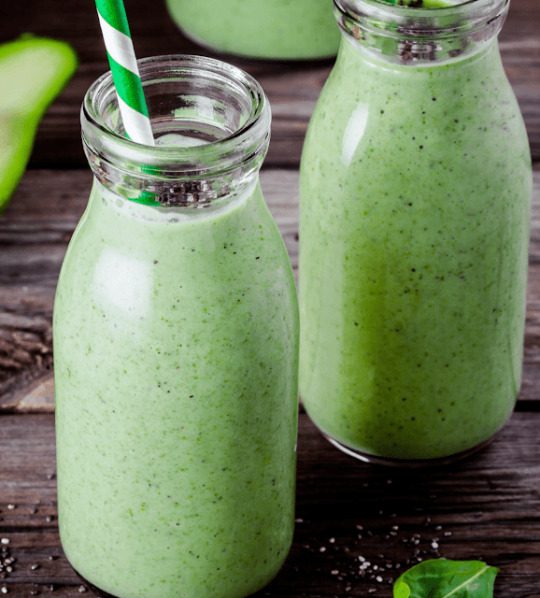
Food Delivery
The recent convergence between food, technology and portability has been dramatic and literally changed the restaurant industry topography. In 2019, the average revenue per user (ARPU) in the restaurant-to-consumer delivery segment is estimated at *$232.05, with a market volume of *$16.16bn.
*Statistica

Convenience was always thought to be the driver behind the food delivery phenomenon, however there are multiple reasons for this monumental market shift including: variety, saves time, ability to order at any time, and visibility of options, all of which are significant. The worldwide gross revenue of US$82.7 billion in 2018 is expected to increase to US$137.6 billion by 2023.
Since 2014, online ordering and delivery has grown 300% faster than dine-in-traffic. In fact, most casual dining and fast casual brands have seen a decline in their dine-in numbers as groups like Grub Hub, Postmates, Uber Eats, and Doordash, basically eat into this market and change consumer eating out behavior.
Generational consumer habits have helped fuel the delivery trend, however while 37% of online food delivery consumers are between 25 to 34 years of age, 26% are between 35 to 44 and 11% are 45 to 54. Therefore, demand is spreading across all age groups. Higher income consumers are the largest user group representing 43.1% of the market vs 25.9% for lower income buyers.
The food delivery sector will grow through consumer demand. However, advances in delivery technology will be a major growth factor. For Example, drone delivery and driverless delivery vehicles are in test by several delivery operators, and even the convenience of Alexa will have an impact: a leading c-store brand, Sheetz, announced that its “made to order foods” from all 564 stores can be ordered on Alexa.
This sector will ultimately change the operational structure of a restaurant, and TNI advises restaurants to get on board or be left behind.
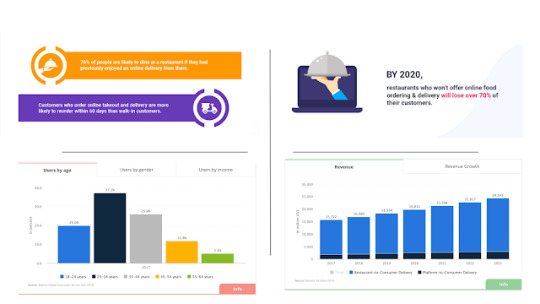
Regeneration of Food Waste
Food waste has become a hot topic in restaurants and viewed as a critical economic and social concern in 2019 by many consumers. Indeed, whereas food waste was historically a profitability issue, it has now become a matter of principal.
Chipotle, for example, announced its goal to divert 50% of its restaurant’s waste from landfills by 2020, through a program of operational improvements, leftover food donations, and general food sustainability training.
However, it is the local level that is leading the way. Independent restaurants are using left over food waste for compost, and innovation is abound: Silo restaurant converts its whey from cheese-making into a sauce for potatoes and turns leftover bread crusts into miso soup, Phood Farmacy uses all scraps from vegetable preparation for vegetable stock and its discarded chilli seeds into chili powder. Viva Vegan plans to dehydrate and convert its discarded juice pulp into crackers and energy bars.
Restaurants are increasingly eco-conscious in order to engage customers, save money and comply with tightening diversion regulations. Composting, converting waste into ingredients, donating leftovers, and swapping single-use items for reusable ones are all signals that food waste no longer needs to be wasted.
Sustainability
While it is hard to find a news outlet today that doesn’t discuss Sustainability, this restaurant trend is still in its infancy. At a general level, restaurants today, (especially brands), are very environmentally unfriendly through the high consumption of power and water, packaging, and waste output.
The World Resources Institute reported ‘approximately one-third of all food produced in the world intended for human consumption is lost or wasted. This inefficiency equates to a loss of $940 billion per year and contributes to 8% of annual global greenhouse gas emissions’
The National Restaurant Association’s State of Restaurant Sustainability 2018 report, states that ‘food waste reduction has become one of the top sustainability issues for restaurants. About half of all restaurants track the food waste they generate, while more than one in 10 compost their food waste, the report found’. However, this is just the tip; some restaurants have moved from oil fried products to air fried products thus eradicating the need for oil and the damage used oil creates in the environment, while others have introduced sustainable fish programs. Packaging, a huge environmental challenge, has seen prodigious changes in the past 5 years. The switch to Hemp, sugarcane and bamboo-based packaging, has resulted in restaurants removing over 47,000 kg of PET plastics from packaging life cycle per year.
TNI Design, a leading restaurant design firm has developed a program that uses hemp-based materials in around 45% of its restaurant finish materials, and reclaimed wood for its furniture recommendations. Lighting is only LED, and research into capital affordable solar power for restaurants has been underway with their new recommended program expected to be launched in 2020. Another example is The Cheesecake Factory, who installed 20, 4-foot-by-10-foot solar energy collectors on the rooftop of its Pleasanton, Calif., location and saves nearly 60,000 pounds of CO2 produced by the restaurant per year.
Going forward, sustainable wall coverings, re-used wood and stone, hardened and processed used plastic, utility saving applications and low energy lighting will all be the norm in building sustainable restaurants.
Technology & Artificial Intelligence
Today’s technology plays such an essential part the food and restaurant industries, it is not possible to report on trends without its’ inclusion.
Restaurant related technologies have previously included online ordering, advance ordering, tablet-based table orders, social media integration, guest-facing technology platforms, and product menu information. Next phase developments with blockchain, digital twin, and artificial intelligence will change consumer interface dramatically over the next ten years (albeit many can’t exactly say how).
Think about a smart menu driven by artificial intelligence, whereby a customer’s food order is based on historical ordering patterns, nutritionally bolstered by the customer’s body type and medical history, produced by a 3d printer, priced based on the consumer’s blockchain credit assessment, paid for by a cryptocurrency, and delivered by an interactive robot. Not Possible – think again!
In 2019 the technologies that will trend most are anticipated as follows:
Blockchains deployed for tracking within the food chain (as well as other areas)
Technology in custom nutrition-based diets
Robotic chef kitchens
Drone delivery
Driverless delivery vehicles
Restaurant cryptocurrencies
Google Eyewear with face recognition software
Enhanced intelligence applications with prediction technology
Voice-controlled virtual assistant
Predicting the long-term horizon where the US restaurant industry is transformed by blockchain and AI is challenging. However, given the momentous oscillation of automation the possibilities are infinite. For example, one German company is developing the world’s first fully-automated, blockchain-powered pizza operation, what would Dominos do with that?
Current On-Trend Food and Drinks to Watch Out For
Ayurvedic food - Indian practice of holistic medicinal remedies infused with regular daily food
Drinking vinegar and vinegar infused drinks
Quinoa derivatives eg: chocolate-covered quinoa snacks, pasta and milk
Jackfruit
Moringa, a superfood powder and/or oil now available in bars, snacks and teas
Matcha
Functional mushrooms
Cucumber infused drinks
Sparkling coffees and sparkling sap-based water drinks
Algae and algae-based products
Ancient grains (Sorghum being one of the most popular)
Sea Vegetables
Street Food; still a growth trend, a great example being The Hungry Trader in Los Angeles, where street food from the silk routes has been modernized while keeping its heritage and authenticity.
About the Author, Robert Ancill
ROBERT ANCILL is the founding partner and owner of The Next Idea Group, an international food and restaurant consulting group based in Los Angeles, CA. He is considered one of the most authoritative voices on restaurant and food trends and has consulted on launching and positioning many new and existing brands in the USA as well as international emerging and frontier markets.
Contributors
Editor: Thelma Weaver Senior Marketing Consultant, The Next Idea
About The Next Idea
The award-winning Next Idea [TNI] is an international restaurant & hospitality concept development and management group of companies. Based in Los Angeles, TNI works across the world specializing in concept creation, development, and management. Everything from research, strategy, brand and product development, franchising through to design, execution, systems and operations, marketing and communication.
The TNI team has consulted with some of the world’s most eminent chefs and upscale restaurant groups in addition to working with clients in entertainment, casual dining, fast casual dining, resorts, theme parks, and travel. In each project, TNI has been involved in all areas of the business and has delivered programs and plans that have targeted the elevation of concept positioning, product and menu, design, operating standards, infrastructure, and overall quality.
For Information contact: [email protected] / (001) 818 887 7714
Investment and Franchise Opportunities in new start-up and existing brands mentioned in this Research please email: [email protected] or call 818 887 7714
Websites:
Franchise Solutions: www.tnifranchise.net
Consultancy: www.thenextidea.net
Design: www.tnidesign.com
Blog: www.globalrestaurantconsultant.com
Awards
Best End-to-End Hospitality Business Consultancy (Travel Hospitality Awards) 2017 & 2018
Most Innovative Hospitality Consultancy Group (USA Today Corporate) 2018
City Beat News 5 Star in Customer Service (2013, 2014, 2015, 2016, 2017, 2018)
Most Innovative Hospitality Consultancy Group (LUX Hospitality Awards) 2016, 2018
Glossary
Research sources for this report include:
The Next Idea ground team
The Next Idea marketing department
The Farmacists at Phood Farmacy
Statistica
Allied Market Research
Bharat Book
Oxford Martin School (Oxford University)
Mintel
Co Bank
The World Resources Institute
Grand View Research
Nielson
Euromonitor
Forbes
Label Insight
Fast Company
National Restaurant Association
Photography and Graphics:
Robert Ancill
Various internet sources
For Information contact: [email protected] / (001) 818 887 7714
Investment and Franchise Opportunities in new start-up and existing brands mentioned in this Research please email: [email protected]
or call +1 818 887 7714
Websites:
Franchise Solutions: www.tnifranchise.net
Consultancy: www.thenextidea.net
Design: www.tnidesign.com
Blog: www.globalrestaurantconsultant.com
#The Next Idea Restaurant#Restaurant Consulting Firm#Restaurant Consultants#Restaurant Marketing Ideas#Restaurant Marketing Plan#Restaurant Design Ideas
0 notes
Text
Global Diagnostic Imaging Market Insights, Trends, Size, Share, Outlook, And Opportunity Analysis, 2021-2025
Disposable medical devices sensors are the need of the hour because of the relative ease of use, cost-effectiveness, non-infectious nature and the major one being faster response as well as more rapid results. With increased usage of analytics in the healthcare field, efficient data gathering will play an essential role in getting adequate results. Thus, the disposable medical devices sensors will play a significant role in achieving appropriate data needs. These devices are used to measure basic vital signs such as heart rates, breathing rates, pulse transmit time, temperature, blood oxygenation levels and others where changes help in identifying an anomaly of any sort. The new technology can be credited for this expectation as various advancements are allowing companies to make distinctive devices with better features and unique services. For instance, Ibis Biosciences has developed a machine which is capable of identifying around 1000 common disease-causing pathogens within few hours of blood sample collection, accurately.
Get Sample Reports Here - https://www.kennethresearch.com/sample-request-10064925
The market is expected to grow at a rate of XX% during 2017-22 from a valuation of USD XX in 2017 to USD XX in 2022.
Market Dynamics
The primary driver of the disposable medical devices sensors market is the increasing ubiquity of chronic and long-term diseases. According to World Health Organization, chronic disease prevalence is going to increase by 57% by the year 2020, a serious concern. Another significant driver is the surging concern over healthcare-associated infections and contaminations also known as Nosocomial infections. Urinary tract infections are the most common healthcare infections among all age groups. These diseases also depend on the kind of facility into which a person is admitted. Thus, disposable medical devices sensors can help in maintaining hygiene standards. Another market accelerator is the support associated with Government initiative for research and development in the healthcare industry as well as increasing investment by venture capitalist firms. Furthermore, the market is driven by rising need to reduce healthcare costs through low-cost medical devices and technology. Currently, Point-Of-Contact Testing (POCT) has helped with reduction of costs by reducing manual labor associated with healthcare. Thu, advancement in such technologies and disposable equipment related to it, will inevitably drive the market growth. However, stringent Government regulatory procedures and lack of reimbursement policies may hamper the growth of the market.
Market Segmentation
The Global Disposable Medical Devices Sensors Market can be segmented by product, by application, by end-user, and by geography. By product, the market can be categorized into wearable, implanted, ingestible, invasive sensors and strip sensors. The market can be divided by application into patient monitoring devices, diagnostic testing devices, therapeutic devices and imaging devices. Each category is further subdivided into at least four divisions. By end-user, the market is segmented into hospitals, diagnostic laboratories, home care and clinics. By region, we can divide the market into North America, Europe, Asia-Pacific and, Middle East and Africa.
Geographical Analysis
North America and Europe account for the majority of the market share because of established competencies in the healthcare industry. However, Asia-Pacific market will grow at the highest CAGR owing to increasing medical tourism, healthcare expenditures, raising awareness and rising per capita income.
Key Players
The crucial players in the market are Medtronic plc, GE Healthcare, Philips N.V., Smiths Medical, Freescale Semiconductors Inc., TE connectivity and Honeywell International Inc.
Report ContentsRegional AnalysisReport Highlights
Market segments
Market Drivers, Restraints and Opportunities
Market Size & Forecast 2016 to 2022
Supply & Demand Value Chain
Market - Current Trends
Competition & Major Companies
Technology and R&D Status
Porters Five Force Analysis
Strategic and Critical Success Factor Analysis of Key Players
About Kenneth Research
Kenneth Research is a reselling agency providing market research solutions in different verticals such as Automotive and Transportation, Chemicals and Materials, Healthcare, Food & Beverage and Consumer Packaged Goods, Semiconductors, Electronics & ICT, Packaging, and Others. Our portfolio includes set of market research insights such as market sizing and market forecasting, market share analysis and key positioning of the players (manufacturers, deals and distributors, etc), understanding the competitive landscape and their business at a ground level and many more. Our research experts deliver the offerings efficiently and effectively within a stipulated time. The market study provided by Kenneth Research helps the Industry veterans/investors to think and to act wisely in their overall strategy formulation
Contact Us
Name: David
Email: [email protected]
Phone: +1 313 462 0609
1412, Broadway,
21st Floor Suite MA111,
New York, NY 10018
0 notes